#so new players have more context and lore than ever before
Note
which media is Norton from? i'd like to check it out!
PLEASE!!!!! hshdjwdunwd he's from a cross platform pc/mobile game called Identity V which is a 4v2 survival horror game! If you know anything about dead by daylight, is extremely similar to that. But I think the story and characters are more interesting. A lot of it is based on lovecraftian horror.
#i got into it by reading all the characters wikis#and then playing it#a lot of lore and context is left out and it DOES get added to the main plot eventually#bit by bit#but its so fun#bc a lot is left out it allows you to use your imagination a lot but they also give enough info for it to be coherent#rn is a good time to start bc theyve just added the second cinematic playthrough of the main storyline#so new players have more context and lore than ever before#anyways!!!!!!#if you get into plssss bug me about it i love talking about it and being helpful!!#ask#mutual ask#cloudsnails
3 notes
·
View notes
Text
ok so firesnap made this very good post earlier today about the problems with niki and wilbur’s dynamic, and I have so much brain rot over it it’s getting it’s own separate post.
my general thesis for it is that I don’t mind niki having less going on as a character in s1, it’s that it’s not expanded on in s2 that’s the kicker.
In s1, even pre election, we get a lot more for Niki than is generally credited. Her relationship with Wilbur is central to her character, but that makes sense, because that’s her hook into the story: Wilbur wants her to join because they are friends. Cool! While it’s initially a bit awkward, their cc dynamic immediately gives a sense of warmth and closeness to their relationship that Wilbur doesn’t really have anywhere else. He’s close with Tommy, sure, but in a more mentor/sibling way, and it fleshes him out a bit more to see him bond with someone else. Leading up to the election, we also get more key traits of Niki’s character
1. She’s kind and compassionate, shown through her general demeanor, but also through the creation of her bakery and her deep care for Fungi.
2. She’s very independent, and doesn’t rely on others to form her opinions. We can see Wilbur is probably her closest friend, but she befriends Eret and basically demands that Wilbur be ok with it because it’s her choice, and literally runs against him in the election. It’s an interesting depth to her character that doesn’t really get brought up, and while it is related to Wilbur, it’s still individual development and characterization
3. She’s very vocal about her beliefs, even at a cost to her safety. She is the one to make the giant flag showing her alliegance, she is the one to be most vocal and aggressive towards Sapnap during the pet wars, she’s vocally against Schlatt before nearly anyone else.
None of this stuff is dependent on Wilbur, or is weakened without it. Wilbur is the catalyst for her joining, but her character is still well established without him and enriched with him. This isn’t your typical “woman only exists in the context of a man” to me, because, well, Niki is a strongly characterized firecracker of a character who has strong individual moments and arcs (in s1 at least...).
Throughout Pogtopia, while there’s definitely room for her to do more, especially post festival, I’m not mad about her character then, either. We see strain placed on both Niki and Wilbur as he’s forced to leave her behind, her anger with her treatment under Schlatt, and her stress upon seeing Wilbur’s deterioration. We’re reminded that she’s close to Wilbur, and Wilbur’s kindness to her serves the narrative purpose of reminding us that he is very much still the same person from before, and maybe could be again. It’s not the show stopping arc that other characters have, but it isn’t trying to be. s1 is very much Wilbur’s story with other arcs added in, and Niki being less “important” doesn’t bother me.
What s1 is for Niki is good setup. It’s quite common in media for side characters to be introduced earlier in relation to main characters, and to be more strongly developed later. The best example I can think of is Nico Di Angelo from the Percy Jackson series, or Jaime Lannister from asoiaf. If you left Nico after the third/fourth book, or Jaime Lannister after the first, they would come off as incomplete and a bit one dimensional, but when they start to shine, they really start to shine. Jaime in particular comes off as a plain villain until we get his pov in the third book, and suddenly he’s getting development galore.
s1 sets Niki up perfectly for that: she’s got a strong personality, a set of beliefs and distinct worldview, and a close relationship to a key player who just died, not to mention the beginning of her building her Secret City to keep refugees safe. It could’ve included her more, for sure, but what’s there is a solid base.
In the beginning of s2, we have a Niki forming new relationships (Puffy, namely), navigating the world without her narrative crutch (Wilbur), and generally being in the perfect spot to begin coming into her own as a character, espeically with the Secret City stuff. I’ve talked extensively about the opportunities for her character: being part of the egg arc, getting involved with Eret, being in the new l’manburg cabinet, actually exploring a spiral arc.
But instead, it’s all just... dropped. Call it cc!niki being busy, not being communicated with, etc etc, the fact of the matter is there. Niki as a character completely drops off, and has been kind of fumbling since to find her footing as a character. Unfortunately, that leaves her relationships with Wilbur as the only throughline of consistency, and suddenly Niki goes from a character who started off Wilbur-centric but was veering off in her own direction... back to Wilbur-centric again.
I don’t hate what’s shown! I think it could really work, but the issue is that Niki and Wilbur’s s1 relationship was never built up to carry Niki through three seasons, it was a catalyst for the existence of her character and a nice grounding bond for both of them to have. It’s not that the s1 stuff is bad, it’s that the follow up offered was never carried out, so instead of:
s1: Wilbur heavy with relationship to Niki in the background and s2: Niki heavy with relationship to Wilbur in the background
we get:
s1: Wilbur heavy with relationship to Niki in the background and s2: Niki’s barely there and it’s mostly central to Wilbur.
There’s something very sweet about the Wilbur Niki dynamic that really appeals to me. I like the way Niki’s confidence contrasts with Wilbur’s insecurity, the idea of loyalty to a place through a person, the intimacy of being the last person someone trusts and of course the concept wearing each other’s clothes. The festival scene alone is one of my favorites ever (just like the brain rot over Niki defending Wilbur on inauguration day vs him defending her at the festival... chefs kiss). It’s a good relationship that sets up Niki to be a strong solo character, as well as s1 lore in general setting her up.
But that relationship never should have been the entirety of her character, and that’s why it feels lopsided. It all comes back to s2 failing to deliver on Niki as a character, but I don’t think it’s the fault of the Wilbur Niki interactions or dynamic
tl;dr: s1 Niki, and Wilbur and Niki’s relationship is good and should be kept, we just needed to add more solo Niki in later seasons
210 notes
·
View notes
Text
How to Play as Link in DnD 5e (2.0)

With the release of both Mythic Odysseys of Theros and now the new big expansion in Tasha’s Cauldron of Everything, I figured now would be a good time to reexamine Link with the context of new subclasses, class features, and game mechanics that weren’t around the last time that I built him. While I won’t do this for every character I’ve built before, characters who have new options made available with these updates will get a new rebuild for 2021. If you want to compare and contrast this build to the original, I will link that build right [here].
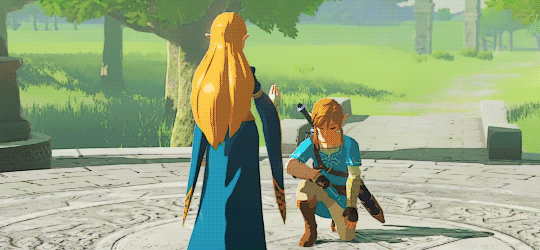
The Spirit of the Hero
Link’s a Hylian and that’s just a fancy way of saying elf. His best racial options are either the High Elf, the Wood Elf, or the Half-Elf. Half-elf’s extra skills are tempting, but as Link is never given any parents or an ancestral family tree, we can’t really justify him as a half-elf. We’ll call him a Wood Elf for the extra +2 to his Dexterity and the +1 to his Wisdom as well as that woodsy vibe. But if you wanna go for a Half-Elf for the power build, I won’t tell anyone.
Link’s alignment is tricky. On the one hand, he is shown kneeling before the monarchy, defeating the forces of evil and darkness, and doing odd jobs to help the common people he comes across. However, he can also start forest fires, break into people’s houses, smash pots, steal people’s life savings or personal belongings, and attack the chicken population until they attack back. I’d wager he’s Neutral Good if for no other reason than his morality is highly dependent on the player.
My first choice for Link’s background would be the Folk Hero for Animal Handling and Survival. However, Link’s background is so inconsistent, it’s easier to just list out the skills he tends to have and tell you to pick a background that has those skills, or create your own: Animal Handling, Athletics, Investigation, Nature, Perception, or Survival. There’s a case to be made for other skills as well. Acrobatics works a little and his jumps did involve sick flips in Majora’s Mask, but Link doesn’t tend to balance or platform jump very often. Link can play instruments fine and danced in the Subrosian Dance Hall in Oracle of Seasons for Performance proficiency, but he’s usually playing instruments to activate effects, not to actually perform for a crowd. Link shows some Stealth skills in Breath of the Wild, but this hasn’t been a longstanding skill of his, so I didn’t lump it in with his main skill list.
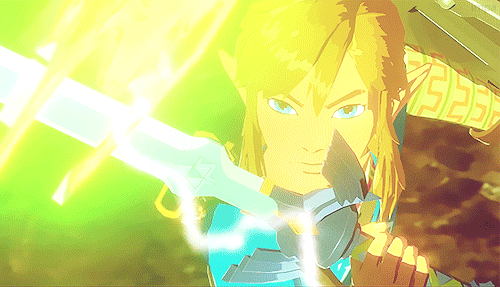
Becoming a Hero
When it comes to his build, Link has made some use of spells in the past, but he’s nowhere near the spellcaster that Zelda and Ganondorf are. Link is definitely more of a martial fighter who augments himself with a wide arsenal of magical items. So when it comes to picking Link’s class, we have a few things to keep in mind.
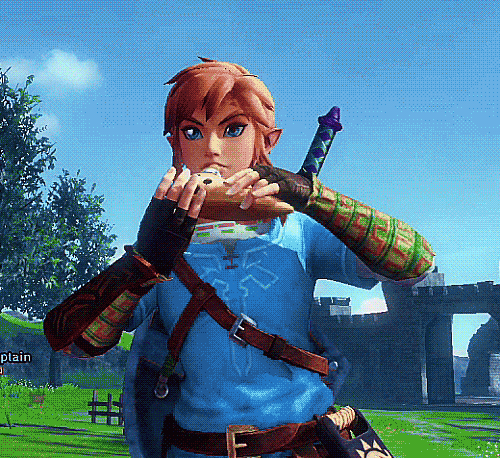
BARD
Link is a talented young man, and he has had magical instruments in a few games over the years, as well as dancing in Subrosia, among other things. While I don’t subscribe to the idea of Link being a bard myself, I understand why people would come to this conclusion, as Link isn’t really bad at anything... except talking. And lying. And looking threatening. Or haggling. Yeah kind of hard to depict Link as a CHA caster who isn’t proficient in any CHA skill checks.
Spirits (UA) This doesn’t fit for every Link, but especially for Breath of the Wild where Link gets help from the spirits of his fallen comrades, the flavor of calling on the dead works for Link. For a non-BotW example, maybe Link can tell stories of his past lives, and the memories he shares with each of them.
Valor This college has the downside of being built as a cheerleader, while Link really should be built for solo-combat since that’s how he approaches most fights. But Valor is better than Swords and also gives Link proficiency with martial weapons and shields, while Swords does not.
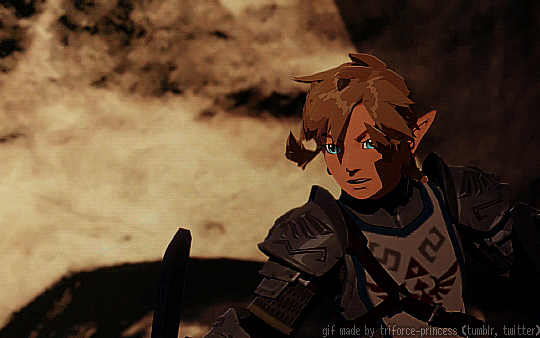
FIGHTER
While there are many martial classes, the Fighter differentiates itself by being the most down-to-earth option. It’s not beholden to rage, or smites, hunting, or sneaking. It is the simple skill of the blade, and this is a skill Link has in spades. From the earliest games, Link has been a master of the sword, the shield, and the bow.
Battle Master Link is a strategic fighter. He looks for weak spots, and he exploits them the best he can. Of all the fighter subclasses, none is more clever than the Battle Master. Its many maneuvers resembles the numerous sword techniques Link has learned especially in the later games. Even in Smash, Link showcases how clever he is by being able to combine his arrows with his bombs and shoot a bomb arrow. To my knowledge, none of the other characters can combine their abilities like this in Smash.
Cavalier The subclass is poorly named, and was better in its initial name as the Knight, as that is really what this subclass is. It is the idea of the knight in shining armor. They can also be flavored as bodyguards, a traveling sellsword, or castle guards. So Link does not have to be glued to Epona to make use of this subclass. The main reason to want this subclass is the Warding Maneuver, as giving Link the chance to either block or reduce all damage he takes is going to seriously improve how well he can tank a hit, and help keep him in a fight longer.
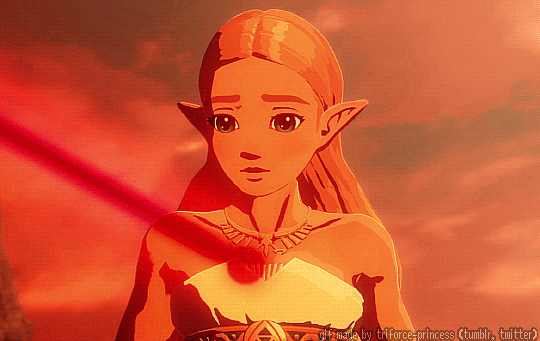
PALADIN
More than any other class, the Paladin actually stands for something. They fight for a value or a belief. They swear their life to a cause and are prepared to die fighting for it. Link works on a lore level as a Paladin. Especially when he’s dedicated multiple lifetimes to the same cause. Across every timeline and game over screen, Link has always returned and stood in defiance against whatever evil may come.
Ancients This oath makes Link sworn to the forces of nature, such as the Great Fairy, and protecting the balance and harmony of the light, life, and love against death, decay, and darkness. The Ancients Paladin is all about protecting the balance in the world and valiantly opposing evil wherever it might arise. It also has a druidic or fey aspect, which kind of works for Link.
Crown With this vow, Link serves the Hyrulian Royal Family. This makes Link the princess’ personal knight, and an agent of lawfulness, order, and peacekeeping in the land. While 5e has backed away from typecasting Paladins as Lawful Good, this is probably the most Lawful subclass one could pick, as it places the authority of the royal family above all else.
Glory Instead of being sworn to the light or the law, the Glory Paladin is the harbinger of the goddesses. They are flavored as legendary heroes of destiny, possibly being demigods or the personal errand boys of the setting’s pantheon. This subclass is clearly focused on being a frontline warrior, and the features make Link a true force on the battlefield.
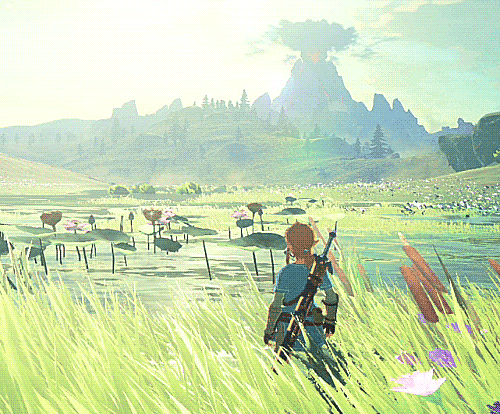
RANGER
Anyone who’s played Legend of Zelda knows that Link is very good at surviving. The games don’t tell you how to navigate the wilderness, Link just has to figure it out for himself. What’s more, Link may be willing to venture into the wilderness, but he’ll be hard-pressed to find many NPCs that far outside of settlements or cities. Yet what they fear, he thrives in. And it’s no wonder that this is the class most peole would assume for Link.
Hunter This conclave is the slayer of all things that threaten civilization. They can choose to be better at chipping away at one enemy, counter attack bigger monsters, or mow through hordes of minions with more ease by taking out multiple at a time. Especially at higher levels, this conclave excels at ripping apart Ganon’s forces with nary a golden curl out of place.
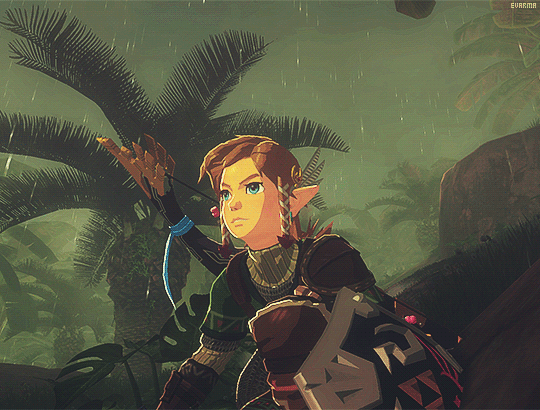
ROGUE
The rogue doesn’t need to be a wanted criminal on the lamb. They can be a clever fighter with a variety of skills and a knack for evasion. That speaks a lot more to Link’s skill set than one might assume at first glance. It’s not a perfect fit for Link, but it’s really not that inaccurate either.
Inquisitive This roguish archetype is defined by being clever in combat, looking for weak points to exploit. They’re also much more observant, making them better at discovering clues or secret passages, or telling when they’re being misled. At higher levels, their ability to look for weaknesses can even increase their sneak attack damage. This especially fits some of the older games where boss fights were focused on using items to exploit the dungeon boss’ weaknesses, rather than hacking away at their health bar. In these older titles, Link was less of a straight up warrior and more of a clever trickster pulling off strategic victories.
Scout The Scout Rogue has heavy Ranger vibes, as they get free expertise in Nature and Survival, enhanced mobility, the ability to disengage from fights more easily, and at higher levels become masters of ambushes. This fits well with Link’s sneakier sniper playstyle that can be done in Breath of the Wild, as Link can take out entire camps without ever being seen.
Thief While Link is not a standard cutpurse, Link is a treasure hunter, a dungeon delver, and the jokes about him robbing the people of Hyrule and breaking into people’s homes doesn’t exactly help. The thief also gets to use more magical items, allowing Link to use things such as enchanted instruments without being a bard.
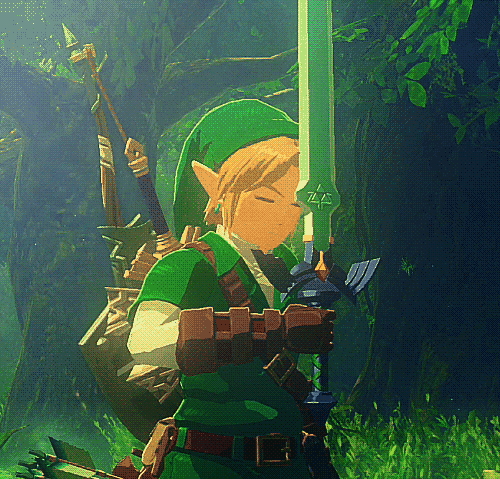
WARLOCK
Link usually isn’t the hero of his own volition. He often starts his journey with Triforce of Courage, a source of power gifted by his patrons. It’s honestly a weak connection, but it loosely works, so I’m including it.
Celestial While this subclass is geared toward serving something other than a god, I don’t see any reason why a Celestial Warlock couldn’t serve the Triple Goddesses of Hyrule or even Hylia/Zelda directly.
Hexblade The most obviously martial warlock option, this is a good choice if you want to incorporate Fi into your character.
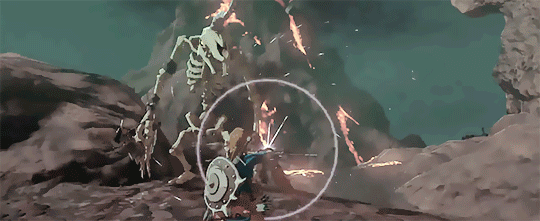
Link’s Toy Chest
Hero’s Sword - Longsword (+1-3)
Mirror Shield - Repulsion Shield
Hero’s Bow - Oathbow
Gale Boomerang - Storm Boomerang
Fire Rod - Wand of Fireballs (requires spellcasting)
Mastersword - Sword of Zariel, Holy Avenger Longsword*
Hylian Shield - Shield of the Hidden Lord
Goddess Bow - Ephixis, Bow of Nylea
Golden Gauntlets - Gauntlets of Ogre Power
Zora Tunic - Cloak of the Manta Ray
Pegasus Boots - Boots of Speed
Hover Boots - Boots of Levitation
Hook Shot - Rope of Climbing

SIDEKICKS
Sidekicks are a new edition from Tasha’s that let Link bring allies on his hero’s journey. Experts are skill monkeys who focus on Help actions, Spellcasters dip into the INT, WIS, or CHA spell lists, and Warriors are trained to fight and don’t have to talk, so they can be animals.
Epona - Defender Warrior Riding Horse
Navi - Expert or Healer Spellcaster Sprite
Sidon - Attacker Warrior Merfolk
Sheik - Expert Noble (Elf)
Wolf Link - Attacker Warrior Wolf
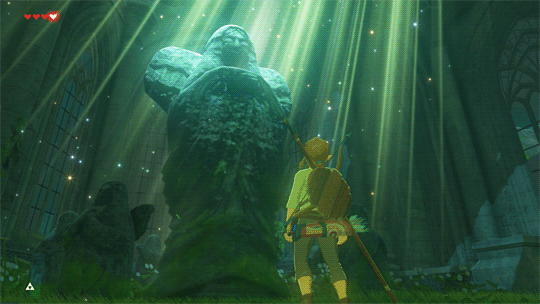
Theros Piety
The Piety System from Theros lets us be devout to a god and earn features from worshiping them. As far as I’m aware, this is an optional feature, and not every DM will make use of these, but if you’re able to, here’s a handy guide. These gods really stood out as the clear choices for Link to go with.
Iroas - God of Victory
Domains: War
Virtues: Achieve a great victory, Overcome slim odds honorably, Defeat a foe in single combat, Perform a great feat of strength or skill
Sins: Being a coward in battle, Beat an honorable foe through deceit, harm innocents
Piety Bonus:
+3 Learn Compelled Duel spell
+10 Learn Crusader’s Mantle spell
+25 For 1 minute, creatures cannot gain advantage on you
+50 Increase STR or CHA by 2 to a max of 22
Keranos - God of Storms
Domains: Knowledge, Tempest
Virtues: Solve a riddle or puzzle, defeat an unwise enemy, plan ahead for an upcoming challenge, build or restore a temple to Keranos
Sins: Jeopardize others through foolishness, ignore a wise course of action, fail to plan for a challenge, give in to anger or self-destruction
Piety Bonus:
+3 Add 1d6 lightning damage to melee attack up to INT mod turns.
+10 Reroll a failed INT or WIS saving throw
+25 Advantage on Initiative rolls
+50 Increase INT or WIS by 2 to a max of 22
Nylea - Goddess of the Wild
Domains: Nature
Virtues: Help any wild animal, stop those who hunt for sport or profit, win an archery competition, slay an aberration, fiend, or undead
Sins: Kill an animal without reason, Dedicate a building to or make a sacrifice for any god (including Nylea), protect a city from a natural disaster
Piety Bonus:
+3 Learn Hunter’s Mark
+10 Learn Speak with Animals
+25 Attacking creatures must pass DC 15 WIS save or change targets.
+50 Increase DEX or WIS by 2 to a max of 22

Cunning Tactician
Battle Master Fighter (12)
Inquisitive Rogue (8)
Fighting Style: Dueling
Maneuvers: Brace, Disarming Strike, Feinting Attack, Parry, Precision Attack, Riposte, Sweeping Attack
Tools: Thieves’ Tools, Mason’s Tools
While Link is brave and strong, he is most defined by his clever mind and unorthodox solutions to boss fights. With this class split, Link has prioritized strategy and tactics over everything else. While it leaves him a little squishier, Link is still a very capable warrior. As a Battle Master, he got a free tool proficiency. Mason’s Tools allows Link to find secret passageways in stone walls, which most dungeons tend to be made of. On top of that, with his Feinting Attack, Link can give himself advantage, meaning he can use Sneak Attack even in a 1v1 fight, which fits his solo adventurer playstyle.
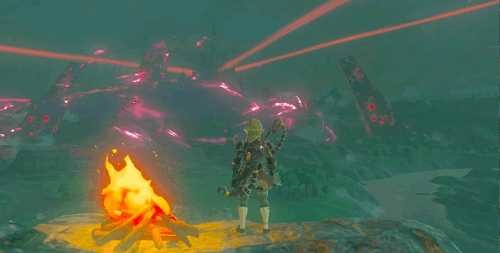
One-Man Army
Battle Master Fighter (12)
Hunter Ranger (8)
Fighting Style: Dueling, Archery
Maneuvers: Brace, Disarming Strike, Feinting Attack, Parry, Precision Attack, Riposte, Sweeping Attack
Hunter’s Prey: Colossus Slayer, Multiattack Defense
Tools: Mason’s Tools
I used this build once in a level 10 campaign. 6 levels of Fighter, 4 levels of Ranger with a +2 Longsword, and let me tell you something. This build creamed the competition, which was the other PCs at the table, who were also built as level 10 characters. Link nearly defeated his first opponent in a single round, dealing around 70 damage between his four attacks. When I say this is Link’s “power�� build, I mean it. I didn’t even sweat when an adult blue dragon showed up after the tournament ended, that’s how much faith I had in Link’s ability to fight. I honestly forgot to even use Link’s battle maneuvers, he was just dealing so much damage that it slipped my mind. You could swap Battle Master for Cavalier, but for me, the Battle Master is more accurate to Link’s favor of techniques over basic hack-and-slash.
RANGER SPELLS
1 Absorb Elements, Ensnaring Strike, Hunter’s Mark
2 Cordon of Arrows, Healing Spirit

The Hero of Hyrule
Battle Master Fighter (12)
Glory Paladin (8)
Fighting Style: Archery, Dueling
Maneuvers: Brace, Disarming Strike, Feinting Attack, Parry, Precision Attack, Riposte, Sweeping Attack
Tools: Mason’s Tools
As a Glory Paladin, Link is driven by a desire to be a legendary hero, and at least in the UA version, the Glory Paladin served the gods, as Link does. Like the two builds above, Link balances the brute might of the Glory Paladin with the tactile diversity of the Battle Master.
PALADIN SPELLS
1 Cure Wounds, Divine Favor, Guiding Bolt, Heroism, Protection from Evil and Good, Searing Smite, Thunderous Smite, Wrathful Smite
2 Branding Smite, Enhance Ability, Find Steed, Magic Weapon, Warding Bond
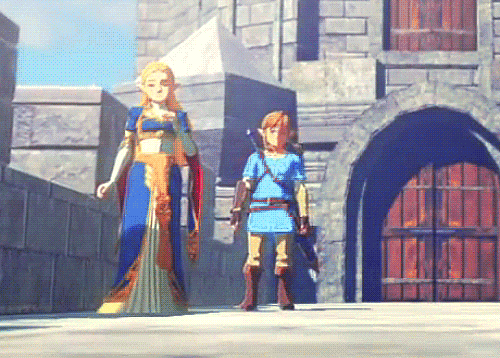
Oaths and Promises
Glory Paladin (12)
Celestial Warlock (8)
Fighting Style: Dueling
Pact: Blade
Invocations: Eldritch Smite, Improved Pact Weapon, Maddening Hex, Relentless Hex
The builds from here on are more for the flavor than necessarily Link’s character. As a Blade Pact Paladock, Link becomes a CHA-focused martial with some extra spell slots that turn his smiting sword strikes into a bokoblin slurry machine. This build focuses Link more as a servant of the gods than anything else. Just make sure he has the Hex spell, but you can replace Maddening Hex with Agonizing Blast if you want to use the Master Sword laser beam at full potential.
PALADIN SPELLS
1 Divine Favor, Guiding Bolt, Heroism, Protection from Evil and Good, Searing Smite, Thunderous Smite, Wrathful Smite
2 Branding Smite, Enhance Ability, Find Steed, Magic Weapon, Warding Bond
3 Blinding Smite, Crusader’s Mantle, Elemental Weapon, Haste, Protection from Energy
WARLOCK SPELLS
C Blade Ward, Booming Blade, Sword Burst
1 Armor of Agathys, Cure Wounds, Hex
2 Lesser Restoration, Misty Step, Shatter
3 Spirit Shroud, Summon Fey
4 Galder’s Speedy Courier

To Serve and Protect
Battle Master Fighter (12)
Crown Paladin (8)
Fighting Style: Dueling, Interception
Maneuvers: Bait and Switch, Brace, Disarming Strike, Goading Strike, Parry, Riposte, Sweeping Attack
Tools: Mason’s Tools
Link is Zelda’s knight, bodyguard, and servant. So this build prioritizes features that makes Link the loyal emissary of the Princess of Hyrule. As such, this build changes Link’s role to be more of a defender to the princess than a solo hero. This build assumes that the princess or someone else who needs to be protected is joining Link on his adventure.
PALADIN SPELLS
1 Command, Cure Wounds, Divine Favor, Heroism, Compelled Duel, Searing Smite, Thunderous Smite, Wrathful Smite
2 Branding Smite, Find Steed, Warding Bond, Zone of Truth
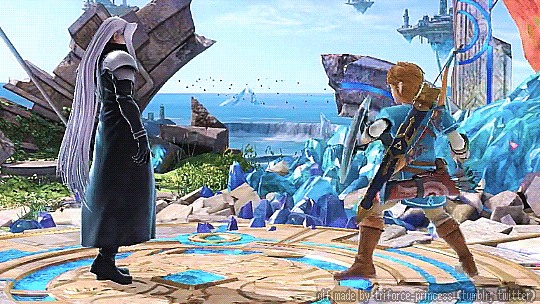
After all is said and done, I hope I gave everyone a lot to work with. Of course my suggestions are not law, and if nothing else, I hope it gives you an idea of how you want to build him. Last time I built Link, I gave one set build for him, but I still laid out other options. Recently though, I’ve been trying to show multiple builds at the end of my build posts to offer a wider idea of what building a character can look like. Happy 2021 everyone, and let’s hope this year goes smoother.
#legend of zelda#the legend of zelda#link#the hero of time#spirit of the hero#hyrule#hero of hyrule#princess zelda#dnd#dnd 5e#dnd fifth edition#dnd 5th edition#tashas cauldron of everything#tcoe#Fifth Edition#5th edition#dungeons & dragons#Dungeons and Dragons#breath of the wild#botw#dungeons and dragons fifth edition#dungeons and dragons 5th edition#botw2#triforce#triforce of courage#loz#nintendo#zelda#ocarina of time#majoras mask
230 notes
·
View notes
Text
a VERY in depth look at fire emblem: three houses and its grooming problem
OR: how this game managed to make an accurate portrayal of grooming and exactly how it made it palatable
(warning: really long. though to be fair, the length is mostly screenshots. you can also read this in google docs)
***
SO i’ve been wanting to write something Formal and In Depth for a while, because this game’s reception has been a nightmare for me and other csa victims and quarantine hit, so i finally had time. i just really wanted to get all my thoughts in one place before i move on from 3h. i’m basically done talking about this after this one because... idk what else i could say that hasn’t been said here, really. fe has history with this, and the in-game excuses ring hollow when we know the fe devs disregard csa victims at every turn while pandering to male gamers who love sexualised teenage girls.
long, long analysis under the cut:
Some previous context: Fire Emblem games have a history of normalising harmful romances
It’s understandable for many to not know the history of the series since 3H was insanely successful and it brought a lot of new fans. Fire Emblem has always been a character driven game where making your units bond was encouraged both for gameplay and story reasons. Some end in special romantic epilogues, and some of those relationships were concerning to say the least: Sylvia, 14 years old, can marry every eligible man in Genealogy of the Holy War, Jill from Radiant Dawn, 18, can marry her father’s protegé who is 34. This is not a new phenomenon for the series, it just became more noticeable and malicious post-Awakening, because it became first person fanservice.
FE decided to rehaul the series sometime in 2011 by including dating sim elements, which made it explode in popularity. Avatars were introduced to represent the player in-game, allowing them to marry whoever they wanted. The first game to include a pseudo-dating sim was Awakening, released in 2012. The player can marry every named playable character, on top of the usual FE shipping mechanics . Donnel, Nowi and Ricken, all children, are part of your party. Nowi is a thousand year old dragon that looks like a child of 11-15. She loves playing, and throws tantrums, and overall acts very childishly, but the narrative insists that she’s really an adult feigning childishness.
In Fire Emblem lore, dragons are veeeery slow ageing people with the power to transform into dragons, which means they can be biologically still children even when they’re hundreds or thousands of years old. Tiki, another similar character, is considered a child in Shadow Dragon by her adult dragon family while explicitly being around Nowi’s age. Despite evidence to the contrary, Awakening treats Nowi like an adult who can marry. Fire Emblem had previously included many dragon child characters in the past, but none were romantic options for anyone, and they were considered a younger sibling of sorts. Nowi was a first in the series, and after her inclusion these romances became common with characters like Nyx in Fates and Flayn and Sothis in Three Houses. Worth noting is her design, which is incredibly sexualised. A (not so) fun fact is that the outfit designer of Awakening and Fates was none other than Three Houses’ future director, Toshiyuki Kusakihara:
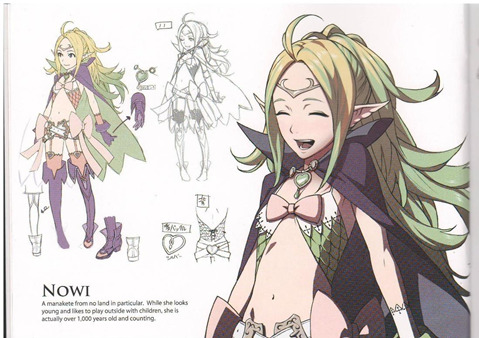
Ricken and Donnel are just regular 13-15 year old boys. No magic. Other adult characters and your avatar just marry them, and it’s stated they will have children in the future. The next game, Fates, actually managed to outdo this somehow: Your pedophilic romance options are now five, and unlike Awakening’s avatar Robin, whose age was unknown and could potentially be portrayed in their mid-teens, Corrin canonically is in the 18-21 age range, making this unambiguous pedophilia. Fates is a very standout game when it comes to Fire Emblem’s worst parts: There’s no “children from the future” excuse for the avatar having children like in Awakening. The avatar impregnates all spouses (or gets pregnant) and has the child after an in-game time skip, which means you can canonically impregnate your approximately 15 year old sister in a Fire Emblem game. You really do not want to stan these devs.

pictured: definitely not 18, even if the english localization really tried to pull that.
Which is yet another thing in this game: Incest with adopted siblings is possible and even encouraged. Incest is constantly fetishized through the character of Camilla, who is an attractive and sexualized older sister obsessed with the main character. Another (not so) fun fact is that most characters will continue to call you ‘brother’ or ‘sister’ in the story even if you’re married because Fire Emblem rarely changes the story to fit with your marriage options. The most insidious thing about the incest and pedophilic couples in Fates is that they’re completely normalized. It’s not shown as abusive, and they look like normal couples that could even look cute out of context. They confess their love, tease each other, blush and have cutesy epilogues.

pictured: marrying your sibling and a literal child
All of this is to end with the conclusion that this is a constant pattern with Fire Emblem, especially the ones with marriage. Any potentially awful relationships portrayed are not outwardly abusive. You won’t catch Xander gaslighting Corrin, or anything. They’re a “cute” relationship that just happens to be incest. Their interactions are not outwardly unhealthy, and it’s tailor made for ‘’’harmless’’’ shipping, but in the end, it’s incest and pedophilia portrayed as a valid pairing that’s “healthy” by all means. It’s normalization of something that’s objectively horrifying to live through. As a CSA victim, Fates literally made me quit the franchise for all the years it was popular.
When Three Houses announced that it would take place in a school while you play a teacher, after seeing all of this play out all FE fans could feel was dread. When 3H announced even later that all romance would take place post-time skip everyone forgot about their reservations instantly— ignoring the fact that everyone being over 18 when marriage happens doesn’t absolve all potential problems with predatory writing. How you write a couple with an age gap is critical. Moving on with Actual Three Houses:
Byleth has a canon age unlike Corrin and Robin, but the game tries to hide it
Corrin and Robin were both avatars meant to be somewhat customized. Byleth cannot be customized. They have a set appearance and age. You can choose Byleth’s name, gender and birthday when you start up the game, but Byleth canonically cannot be born anywhere after September 20th 1159, their “canon” birthday, since their father states in his diary that they’re already alive. 3H starts in the year 1180, which makes Byleth 20 or already 21 depending on their chosen birthday.
All other Three Houses characters have their ages shown clearly in their unit menu, and all bios update accordingly when you learn new information, including yours. Byleth’s age is revealed in a cutscene, but despite this, the game tries to “hide” their age. This is all Byleth has in their bio even well into the endgame:
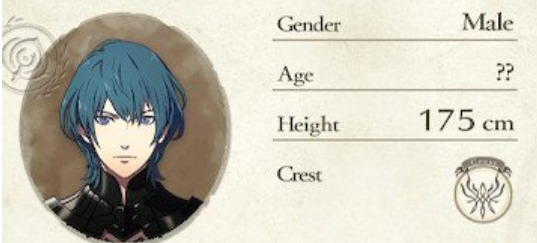
It’s presumably so the player can “headcanon” their age, as the player avatar, but they still have a canon age, because they’re not a customizable one. It’s a very odd design choice that makes no sense until you consider that the game is romantically pushing teenagers at you. Romanceable students range from 14 to 22 years old before the time skip, but the great majority are in the 15-18 range. Early on, when you introduce yourself to your students, they seem taken aback by how young you are and comment how you seem like you’re “their age.” This is your only dialogue option in response:
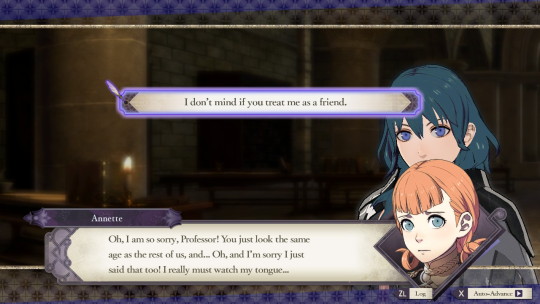
No sixteen year old has ever told a twenty/-one year old that they’re the same age, but this is anime high school dating sim logic. An addendum is that this game has incredibly shallow dialogue options to hide how linear it really is, and this is the first glaring instance. This comes up later on with the romance options—you have little to no options to reject a student’s advances. Boundaries as both a player and RPG protagonist are non-existent in this game.

pictured: “yes” and “sure why not” dialogue options to agreeing to meet with a student alone. linhardt just turned 17 last month
Byleth can flirt pre-time skip
Most of your units are students, thus all romance should in theory, stay in the war phase…. Which doesn’t happen at all. All the narrative framing of characters’ “closeness” and foreshadowing of romance are definitely a part of the school phase. The worst offender by far is an in-game event called the Goddess Tower, the school’s local romantic spot. It’s said in universe that a man and a woman who make a vow there on a specific night will stay together forever, and this is a prelude to the marriage scenes five years later, which will take place in that Tower. You can even pick who to bring with you to the Tower, and this is what Byleth says to themselves before the drop down menu shows up:

this is one of those lines that’s like semi-innocuous, since byleth is addressing the player here, but what the fuck is a teacher doing thinking about a student “that way”???? my girl doesn’t know there will be a 5 year time skip where they’re going to be legal she’s just saying this about a bunch of sixteen year olds.
The Goddess Tower itself is a mess of bungled flirting and unnatural romantic scenes, made all the worse by the fact that you can only trigger this scene with a student. Older characters like Seteth, Catherine and Shamir are locked out of the Goddess Tower. They can’t be picked from the menu, and if they’re your highest support, the game will default to the next highest supported student. Here’s some lines from Ingrid’s scene:
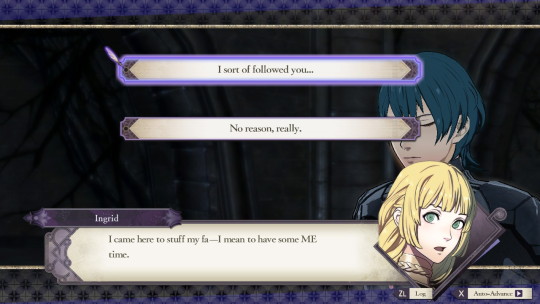
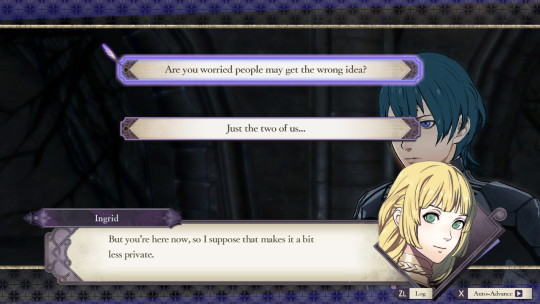


ingrid is 17 when this takes place. the youngest byleth possible is well over 21 and the oldest is turning 22 next month
Check out this post for more examples of the Goddess Tower. Byleth’s dialogue options here are right out of a god damn PSA about child safety. They genuinely come off as a huge creep here, especially “Just the two of us….” My dude.
Thankfully one of the few instances where you can turn the student down, but notable anyway. Dorothea’s C support, where you have the option of following her flirty lead, and her response will be the same regardless of your choice:

Another infamous bit of inappropriate flirting is Edelgard’s Japanese C1 support, which you’re likely to unlock before her 18th birthday in June because it’s her very first support:



This was thankfully removed in the English version (Though she still has the same flustered reaction), but the intentions are there. Curiously, I’ve seen many supporters of the Byleth/Edelgard ship say they were upset this was removed, while simultaneously denying the ship has any grooming connotations whatsoever— when an authority figure making ha ha, unless? 😳 sexual jokes in front of underage/barely legal kids to see their reaction is textbook grooming:
Once a trusting or special relationship is created, the offender may carefully test the victim’s reaction to sex. (x)
Not helping is the fact that Edelgard falling in love with Byleth during the school phase is practically canon judging by dialogue in CF of her missing you “more” than the others. Which leads to:
Some interactions pre-time skip resemble grooming tactics
In fans’ minds the lack of boundaries are somewhat mitigated by Byleth’s supposed good intentions, and it’s common to hear fans say Byleth obviously didn’t go to Garreg Mach intending to marry one of the kids they’re teaching because grooming must be malicious from the start. However, it’s well known that unlike premeditated abuse of younger kids, sexual abuse of older teens often happens by “accident”
In contrast, educators who teach at the late middle and high school level target victims in this age range. They might be outstanding teachers, although they may also be mediocre (Shakeshaft, 2003). Sexual abuse at this level may be less premeditated and planned and more often a result of bad judgment (Shakeshaft, 2004). (x)
In other words, by putting zero boundaries between teacher and students and enabling weird situations, which is 3H to a T. Many students flirt, but Byleth doesn’t say anything, or even flirts back.
Secondly, Byleth is like… barely a character, so this isn’t meant to be a callout post accusing them of being a manipulative abuser or whatever, because this is about the dev team putting teenagers in these flirty positions to satisfy the player that Byleth is meant to represent. Byleth is just the plot device they use to do so. People often say this flirting isn’t grooming because Byleth has “good intentions,” but they’re a self-insert, and a self-insert doesn’t have to have any in-universe intentions because the outside writing drives their actions— the thing is we KNOW these writers are not above writing pedophilia as harmless romance. People project good intentions on Byleth, because that’s the avatar. You’re supposed to project on them. This of course includes their “good intentions,” and when I play 3H I headcanon that too, but canonically speaking, these intentions are 100% ambiguous. They never voice attraction to another student, or disgust at the thought of dating them because they speak in small, limited dialogue options and thought bubbles. We don’t have a real, canon indication that they would oppose dating a student before the time skip nor that they would actually do it.
What we do have are the canonical interactions that make people uncomfortable, however. Byleth can think of students in “that way” when the Gatekeeper describes a romantic getaway on the Goddess Tower. If we take them at face value, then their dialogue options clearly establish that they’re okay with flirting with students as young as fifteen, at the very least. They “die” before potentially starting to date any of them for real, but the beginnings of an uncomfortable romance are there and the game fully embraces this as okay .
This is all a result of the writing. Fates never condemned you for picking your sister over any of the other thirty (?) romanceable characters, just like Three Houses doesn’t condemn you for picking Lysithea over any older women in the teaching staff. It’s just another S support option, and it even gets some sweet extra content. She’s touched that you care for her, and you do everything in your power to take care of her frail health, and you guys get happily married. No one ever mentions that you were her high school teacher when she was fifteen and you met at said high school, and she was your favourite student— and this is, you know, something of an important detail in any relationship. Just like Fates, it’s sweet and shippable out of context, which just encourages normalization. How dare you say this is unhealthy? It’s tender! Look how much he loves her!
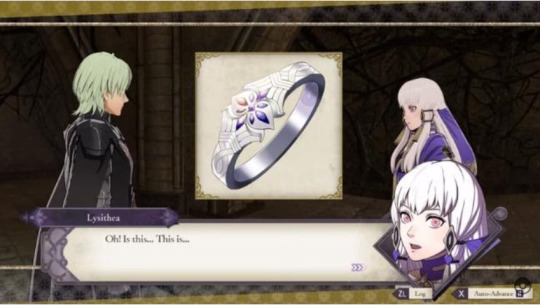
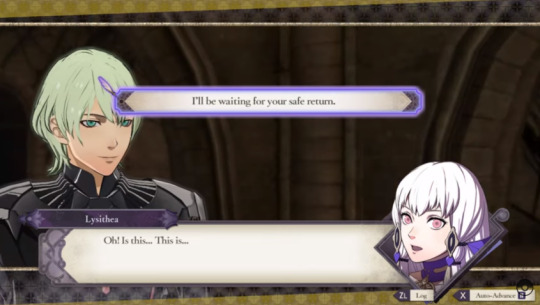
The thing is that 3H initially presents your students as your charges in school. You’re unambiguously in charge of them as both tactician and instructor, even if you treat each other in a familiar way. Even if most students technically outrank you as nobles, Garreg Mach as politically neutral ground implicitly puts you above them as their teacher. The younger ones are vulnerable teenagers, away from home in a boarding school. Most have some sort of underlying emotional problem that they come to you for. They come to you for advice, and sometimes just venting. You can give them gifts, and have tea every week with them if you so wish in an off-screen conversation. Tea also serves as the “skinship” of this game where you get to see the anime boy/girl of your dreams from up-close, which is a pretty creepy thing to do with a fifteen year old anime girl even out of universe, but I digress.
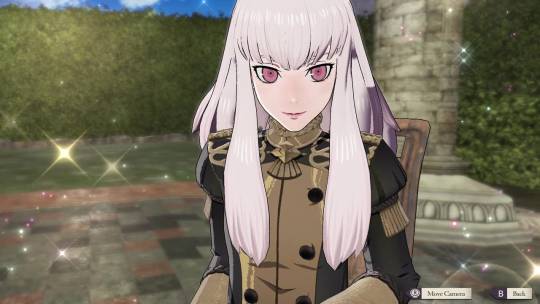
Looking at this chart in the essay I linked earlier gave me a little bit of a stroke, because the “Strategies” aspects are all things you do in 3H prior to the time-skip:
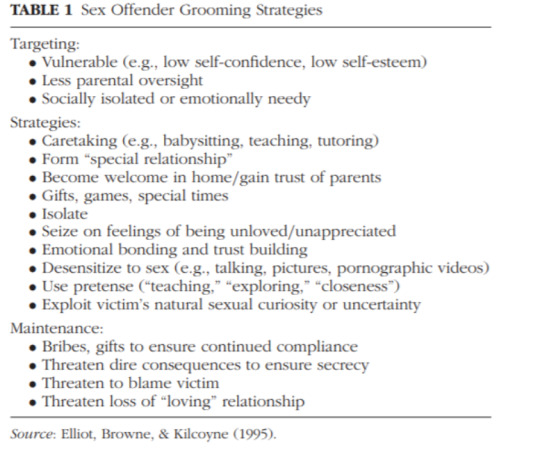
This is obviously accidental, but still concerning because we know these devs have a twisted idea of what romance is, and that culminated in what I sincerely hope is an unintended but still eerily accurate portrayal of grooming.
Emotional confidence, teatime and gifts, flirting, making a vow together at the Goddess Tower, sex jokes, are all things you do pre-timeskip, and some student’s personal arcs make this even worse. Marianne, Dimitri and Bernadetta have mental illnesses, and they heavily rely on you for support. Edelgard and Sylvain express attraction towards you. You meet Felix’s father and he puts his full trust in you. Ignatz, Bernadetta and Marianne have very low self-esteem. Characters like Ashe and Annette have major parental issues that they discuss with you. In short, you see them at their most vulnerable as kids, and then get together as adults.
About the only thing you don’t do pre-time skip in that list is “Isolate,” but some character arcs post time skip have this distinct vibe nonetheless. Many students leave their homes in the war phase explicitly because of you and no other reason. CF Ingrid in particular outright betrays Faerghus and everything she knew for you, as she says she doesn’t really believe in Edelgard’s war. Knowing you as a teacher can string her along in her Goddess Tower scene while she’s underage puts this in an awkward perspective.
This is what makes the five year time skip hold little weight. Everyone is an adult when the relationship is consummated, yes, but it starts pre-time skip.
Emotionally vulnerable teenagers having a strong relationship and frequent alone time with their older teacher, who is a confidant and someone that makes them feel special is already looking bad, but the absolute loyalty, idolisation and close relationship when they’re adults only makes it worse, even if it’s probably just a result of poorly thought out game design and player pandering gone wrong.
It’s not just player pandering, however. The devs just clearly think these relationships are okay. Other non-Byleth student/teacher romances deserve a mention, too—Manuela is forty something and thinks of her romantic potential with some 19 year-old:
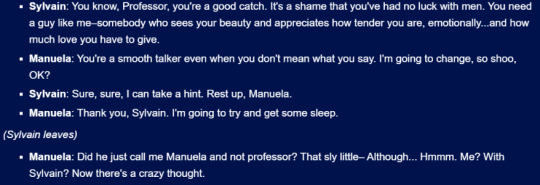
Thankfully, this support ends at B, but others don’t. She has romantic endings with Lorenz, Ferdinand and Dorothea, who she even canonically met before Garreg Mach as a child and who idolises her as an opera star. The game doesn’t stop at the normalisation of grooming with Byleth, they’re just the most noticeable example, especially since it’s a power fantasy for the player who can romance all of them, not just a few.
The time skip had the opportunity to fix some of the creepy implications, but it didn’t
People like to look at the time-skip as a justification of romance. That 15 year old kid is 20 now, after all, and your students are adults, who have matured and grown outside of your influence.... Except your interactions with them remain virtually the same. They still call you Professor and hold you in some extremely high esteem as an authority figure.
Three Houses has an avatar worship problem like all newer Fire Emblem games and this definitely contributes to the uncomfortable implications in the narrative, because literally everyone respects you and adores you to an uncomfortable degree. Even as grown ass adults, the avatar worship just makes it seem like your students still idolize you like when they were kids awe struck by how cool you are.
They don’t show the change from “mentor” to “peer” satisfactorily, like they intended for the romance elements to work. Byleth’s name is customizable, making a first name basis difficult, but they easily could have changed your war phase title to something that would make it seem like your students’ view of you changed, like a military title such as Commander, or even just Eisner, your canonical last name. All students still call you “Professor,” in the war phase, though. Some students even call you Professor when you’re about to propose to them in the S support, like Lysithea. Leonie, one of the oldest students who is actually your age, has this to say about calling you by your name… you know, like a normal peer and friend would:



White Clouds is also a whole year while VW, AM, and SS take place during six to seven months, CF during five. You spend more time as their teacher and mentor than as “peers,” so Leonie’s position is pretty understandable despite being like, barely a year younger than you.
To rewind, this game lets you pick a “special” student pre-time skip, who you’re encouraged to build bonds with through tea, gifts and the Goddess Tower. You’re their favourite teacher, as said by many other characters. They grow up and join you in your war regardless of who they have to fight, some even just to be with you. They still affectionately call you Professor, and look up to you. You can then marry them. This is unironically seen as both acceptable and even romantic.
Many of these interactions like tea are gameplay elements and thus come off as the devs not thinking too hard about it. Except, again, we know they have no problem in writing outright pedophilia, but Fates in particular had heavy backlash over this, which explains the need to tone it down a little. Grooming was their “compromise” between not turning off the casual audience while still cheekily pandering to that crowd. Everyone is technically over eighteen in Three Houses, even if they act extremely similar to their teenage selves. The “technically 1000 year old” romances like Flayn and Sothis were also left intact.
This is an important distinction, because a bit of a popular “it’s not grooming” argument when dealing with the war phase is Byleth’s weird dragon powers slowing their aging. Unlike the kids, all adult non-students in Three Houses undergo no portrait changes during the time skip, including Byleth. The thing is that in Chapter 10, they receive dragon powers as part of some plot nonsense, so it has different implications than just anime hating everyone over 25. There’s implications in the game that this definitely affected their ability to age normally, such as the Flayn ending:
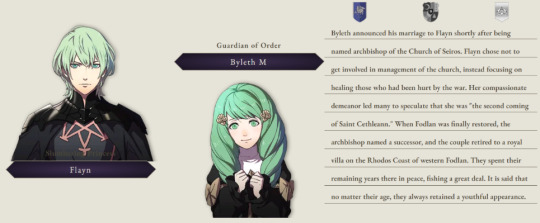
However, we don’t know how their aging was affected and to what extent. Three Houses’ lore didn’t specify much about the way dragons age. Rhea undergoes dragon madness, so we can thus tentatively assume Fódlan’s dragons are similar to Archanea and Valentia’s dragons, which would mean there’s a chance Byleth even aged normally for a few years before slowing down significantly like Nah from Awakening did. It’s entirely possible they’re biologically 25-26 like they’re meant to be, because they didn’t physically die. They were just asleep.
Even if they really did not age a day over 21/22, it still makes the pre-time skip hold weight, however. Byleth can flirt with them as teens prior to any fantastical excuse, and they’re still a mentor figure in the students’ eyes, which goes on to colour every interaction with you in the war phase. Post-time skip everyone is legal, but they still have that history with you, and the game makes no real effort to change that whatsoever. It still fulfills the student/teacher fantasy despite the many, many technicalities it tries to pull out of its ass.
Intsys is self aware and knows that this upsets people
To say these devs probably didn’t mean it that way is not entirely impossible, but they don’t exactly inspire confidence. They even “acknowledge” their flippant way of treating teacher/student relationships in a DLC quest during school phase:

Of course, this is a silly complaint because a teacher being friendly with students is a good thing! Students learn better in a positive environment! The problem here is that it’s obviously referencing and mocking the people upset that this becomes romantic later on. I think anyone would have been able to forgive the overly friendly nature of Byleth and the students’ relationships if no line had been crossed regarding romance. This is Fire Emblem after all, and it wouldn’t be Fire Emblem without supports and relationships values.
But also, Intsys is very good at jokingly acknowledging when they’re being creepy rather than striving to do better. It’s not the first time they’ve done this. A really bold faced example is when the Fire Emblem mobile game widely known for fanservice released a ten year old child (no magic or dragons, either, just a child) dressed as a bride and had her say: “This outfit is just for the [bride] festival, don’t get any weird ideas!” when they were the ones who made a child bride for fanservice purposes.

this one was pretty fucked up even by their standards. comment sums it up
The devs also once called Camilla from Fates a “cow” in an interview for having huge breasts and a little tiara that looks like horns. They designed her that way, but then mocked her for looking like an oversexualized caricature. Any way you look at it, they’re well aware they’re being off-putting and cheekily being like, tee hee, I sure made a dating sim set in a high school! Which ultimately leads to the final point:
Though canon definitely has its problems, it’s less about canon and more about the devs’ bad intentions and the fans’ general lack of empathy for CSA victims:
This is not to diminish canon’s impact at all, because it’s outright malicious to portray an unhealthy relationship as cute and harmless. In short, they just pull technicality after technicality out of their ass to make student/teacher okay somehow instead of just..... not having student/teacher at all. After Fates having fucking incest, 3H and teacher grooming seems outright tame and that definitely contributed to the wide acceptance in the fanbase, because it’s less outrageously pandery. I can’t believe I have to say this in 2020, but…... that’s still not good, lads.
I will also admit there’s some nuance here regarding some of the students, especially those 20+ year olds who aren’t easy to manipulate teenagers like Mercedes. We can sit here and argue all day about whether or not this game legitimately 100% can be considered grooming because of those 20+ students, and all of those in-universe technicalities since there’s no real life academic journal on grooming who will talk about the offender being a dragon, but the end of the matter is that the devs chose to portray their pseudo-dating sim franchise in a school, while your MC is a teacher and most of the students are teens. These relationships are also 100% normalised and okay in-game. They did it with incest and with teacher/student, both topics that are majorly upsetting to CSA victims, and that alone is worth calling out. They even mocked people who were upset about it with a little DLC quest, just to rub it in.
This whole post was a critique of 3H and Intsys, but it’s impossible to critique the game without critiquing the fan culture around it, because the devs definitely had a fanbase in mind. We know they take feedback, since they toned it down after complaints about Fates, but the reason why they didn’t just get rid of pandering aspects, is because they’re popular. There’s a huge demand for this, and that’s exactly why they keep doing it, and it’s the simple reason that online anime spaces full of adults have always placed a particular interest in teens and sexualising and shipping them. A Fire Emblem game set in a school with a calendar and a lot of romantic and social elements that started development in 2017 just screams Persona 5 inspired. Fans obviously noticed.

”edelgard is soooo thirsty” jokes are a lot less funny if you know going for the thirsty kid is a legit strategy
Now, I don’t know shit about Atlus, and after seeing all these memes regarding Persona 5 and the fans’ positive reaction to them, I have zero intentions to play it, but I’ve unfortunately played every single FE game and watched the transition to classic FE to 3DS FE to 3H. I have my criticisms about modern FE’s writing quality for sure, and while I obviously can’t say it used to be perfect because it was still a fairly mediocre (but fun) game about teenagers beating up dragons, it’s now become one of the single most unfriendly fanbases if you’ve gone through any kind of sexual trauma. Incest shipping, pedophilic shipping, and sexualizing teenagers was always there to some extent, but it’s blown up now that the devs have emboldened those fans by doing it in canon itself. It’s rampant, especially on “waifu” circles, and now grooming ships are mainstream and everywhere. Even LGBT friendly “safe spaces” are unbrowsable. F!Edeleth in particular is commonly seen as the holy grail of wlw representation. Linhardt is the most popular M/M option despite the other two being adults. Doromanuela was given a shout-out by Dorothea’s English voice actress.
Old FE games had background things like that all the time, (Roy/Cecilia is Literally gender swapped Petra/Byleth) but the keyword here is background. Not like... 80% of the ships involving the MC in game, which means you weren’t bombarded with this every day. Worse, the discussion about this topic has been non-existent. Reddit has not touched this at all despite the community there being well known for meticulous criticism, Twitter and Tumblr have seen its fair share of discourse, but it’s quickly dismissed. Just click here to watch people dismiss the concerns of every single grooming and CSA victim, or even call them stupid like we can’t recognize this shit in every single fandom. Of note are the fans who dismiss grooming concerns by saying all flirting occurs post time skip (which is false, as we just said) and the characters are only 3-6 years apart anyway……………….. and then gleefully consume/produce pre-time skip content:

miscellaneous tags on a pre-time skip linleth comic (20/21/22 and 16/17 if you’re not keeping count) not posting the comic itself cause i don’t want anon hate lol
While there’s an argument to be made for romance with anyone who was 20+ pre-time skip, there is NONE for the underage kids. None. And like, even if you somehow still want to argue that 3H itself isn’t grooming because of the time skip, a huge chunk of the fanworks objectively are, and this is a huge problem that needs to be called out and nobody does so whatsoever. That comic has 2500+ notes.
This isn’t even a call to tell people to throw out their copies and riot, just to be aware of this and try to make fan spaces a little more bearable for CSA victims. A lot of people call this ‘toxic cancel culture’ and whatnot, but I personally can’t defend a dev team who I KNOW has done heinous things in the past, and continue to support the pedophilic mentality in online anime fan spaces but like, in a cheeky subtle way. They easily could have made Byleth a student who tutors the others because of their experienced mercenary background with Jeralt, or just not let them romance the kids at all. They could have pleased both the dating sim and high school camps by letting you choose to be either a 21+ teacher or a 17 year old student with the appropriate romance options, too. They didn’t do any of this, and their questionable past begs me to ask why, and none of the answers I can come up with are very encouraging. They also even blatantly gave you extra content when romancing students.
I hope contextualizing the 3H grooming at least makes some people understand why it’s so upsetting to see it everywhere. It’s just the decent thing to do to tag your posts, and to not dismiss any of these things. It’s just the decent thing to do to listen to people who are sharing their experiences and respecting their boundaries if they simply do not want to interact with you if you decide to continue supporting Intsys.
Anyway, I hope you enjoyed this. Stan Claude von Riegan.
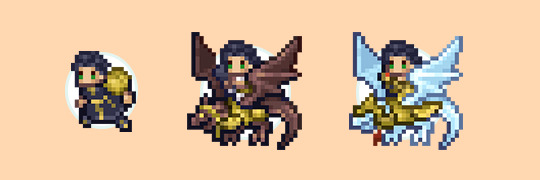
967 notes
·
View notes
Text
Food Fantasy: An Analysis on what killed a Golden Goose (3/3)
Ladies and gentlemen, we've arrived at our final destination.
Again before we start, we have our obligatory disclaimers. I do not own the game or its characters, nor do I claim to know the true history and likely fate of this game. I am entitled to the thoughts and opinions written within this post. Feel free to agree or disagree with the points being made.
This post also remains untagged from the main foofan tag. Only my followers will see this.
We are in the third and final stretch, and the checkpoint is past the cut.
Community
So... here we are, fellow Master Attendants.
As consumers of this piece of entertainment media, we are free to enjoy it however we wish. Appreciating what is there, creating something new from what exists, playing the game by the meta or however you want to play it (within your means and at your own risk of course). There's no one true and absolute way to experience the game.
However, just as you can enjoy something, doesn't mean you can't also point out flaws or shortcomings of the media in question. As an active veteran player, I've already pointed out the many gameplay design flaws already. And I'd be pretty dumb to say that Food Fantasy's writing is perfect. Hell, it has a lot of holes from a worldbuilding consistency standpoint.
And what of things from the community side? Yes, there will be times you'd see content you consider cringe, or something in fanon you don't agree with. Or there happens to be fan theories and fangirling posts you don't like the take of because of X or Y.
And that's fine. If we all happen to play the same way, like the same thing, agree on the same thing and produce the same thing, well, this would be one helluva boring community, wouldn't it?
But what if someone decides the way you're playing the game is wrong and harasses you over it? What happens if someone decides that their interpretation of the game's flavor text and lore is more important than what anyone else thought about it? What happens if someone decides that they're absolutely right, and you and everyone else who disagrees deserves to be bullied out of the fandom?
As much as I want to say we aren't part of the problem why the game is deteriorating, we are unfortunately, part of the reason why the game is as such even if most of the blame is directed towards Funtoy and Elex themselves.
⦁ Whale Authority. Whales will always be part of a gacha game's ecosystem. Without them, the game won't be able to maintain its upkeep costs, moreso for one that services global regions instead of just one. But when a game decides to cater its decisions of what features should be prioritized and when it should be launched around only its most elite paying players' voices -even if that influence has since tapered off-, you know there is something wrong with the publisher's management team and priorities.
⦁ Interguild drama. While I did not personally follow any of this, this has certainly been the peak of in-game tension back in the day. Poaching good players from both competitive and smaller guilds, guild mergers that often ended up making the annexed guild/s the equivalent of UK colonized India or Australia, suck-ups chummying up to guild leaders to keep a spot in an active, high ranking guild (for bragging rights!) despite never contributing much to overall damage, and just general dislike of certain players' attitudes. Actions like this have disillusioned many players about their playing experience and the reason why many eventually just lost the motivation to log into FooFan.
⦁ Cheaters. You know very well about the Hacker-teme I've mentioned before, but that was in context of Elex being incompetent with dealing with them. Here, I would like to point out the players who are desperate to dominate the playing field for whatever reason to the point that they would resort to cheating the ranks with forceful modifications of the APK. Whether it is to rank high in catacombs weekly, get a top spot in daily disaster damage, or weasel their way into the competitive whale ranks of a major ranking event, these are the people who have no qualms messing with the code to give themselves an easier time with the game. And if they're caught? Some pretend that they've made a mistake, some quickly sell the account to escape the blame, some others just scamper away into the dark and hide in the lower ranks where they can't be found. Others simply don't care and keep cheating until Elex decides to finally ban them... if Elex ever decides their rebates score isn't worth saving the account.
⦁ Ship wars. Ah yes, a staple of drama in any fandom. There doesn't need much explanation to this as we've all had our fair share of running into a battleground in whatever fandom we visit. Someone ships BB52 wholeheartedly? Nope, problematic 'age gaps'. Someone likes Napoleon with Pastel? Someone's bound to misinterpret their bios in order to justify that Napoleon was being abusive. Spaghetti and Borscht? Borscht is minor coded, ship her with Vodka instead. Whiskey and Pizza or Cassata? Cancelled! And I've never heard of the Foe Yay trope or pretend I don't know about it! Rarepairs? Disgusting! No fanon in my canon playground! Turkey and Eggnog? Gasp! How dare you, you pedo-shipper-even-though-you-never-said-you-shipped-them-romantically-but-that-isn't-my-point!
⦁ Character Obsession: Bias. On one hand, you love a character so much. Relate to a character so much. You have thus pulled this character into the folds of your bosom and coo at them like a mother dove and get so minutely triggered if someone so much as makes one disagreeable or joking comment about the character that you fly into an overreactive ballistic rage that would make a Canadian goose honk in fear. You don't care what they are in canon. You don't care about the possibility of mistranslation. What matters is the fanon space you carved out for them to exist in and that's all that matters. The problem with this is when this obsession takes over common sense and social etiquette and it steps into harassment territory. You begin to think: I'm the only one who 'understands' the character. I'm the only one who wishes better for the character, everyone else is out to defame them! Oh wait, you like them too? Do you like them the way *I* like them? No? Maybe if you're my 'friend', I'd let it slide. But to everyone else? No one else has the right to like them as much as I do. No one! Never mind that they're completely fictional- No one hurts my bias because in turn, they're hurting *me*!
⦁ Character Obsession: Anti. On the other hand, you hate a character so much. This character just makes you see so much red. Their smug little smirk just makes your blood boil. Their fictional backstory makes you recoil in disgust. You hate that someone else loves a character you hate so much. You cannot *believe* that someone could be so daringly stupid to like a problematic character. They must be problematic too then. They must be hiding real life secrets that are problematic! Yes, yes. That's right. That person's a supporter of abuse. That person's into pedophilia. That person is into military lolita fashion that Japan started the trend of but clearly Japan was part of the Axis Powers! And that... that person... that person... is a roleplayer and a yaoi fangirl properly interacting with minors and adults. How dare they...!
⦁ Fan Translations. Normally it wouldn't be a problem that a group or two or several are translating pieces of the game's lore ahead of the official. But with Elex's very delayed translations and extreme allergic reactions to translating Food Soul bios, people have become dependent on fan-translation groups to get their fix. The problem herein lies... is when the translators get drunk off the power that they are one of a handful in a small community who can magically transcribe the oriental moonrunes into English. The problem starts when the translator starts to have an inclination. The problem starts when the translator loses their professional detachment and start adding in details here and there into the fan translated product that ultimately changes the meaning and direction of the entire story. The problem is also escalated when that translator's embellished product is touted as the truth by their followers. If there was an upcoming character whose backstory is connected to a character they hated (either because of someone or they just don't like the character) and you were hoping to read the fan translation? How would you know that what you get isn't something doctored to the point it's basically fanfiction?
⦁ Social Justice Vigilantism. Sometimes someone does not have a character obsession or need it to be annoying. Sometimes, someone just wants to ring the alarm over something they find 'problematic' in order to police and sanitize the enjoyment of the media for 'everyone'. They no longer really take enjoyment out of a new Food Soul design being leaked, they no longer read the lore just to enjoy what it has to offer. Instead, they nitpick bits and pieces of the design and point it out repeatedly as a reason why the whole thing is bad. They point out bits of the story and inject their interpretations of it without really comprehending what they've read in full and react badly to it. What's worse is that they have no qualms publicly posting their reactions and eagerly and hungrily await those likes and echoes of agreement that they were right.
⦁ Circles of Influence. Everyone has a group they eventually gravitate to in a fandom. It comes with its own pros and cons. Sometimes you join a group because someone you admire is in there, sometimes you join a group because you just want to mingle and see more content. All valid reasons. Arguments can't be avoided in a group, it has to happen... But you have to take care. You have to take care to feel the change in the air of the group. When someone starts pushing people to agree with them. When your most admired people start to feel overly sensitive about certain characters or issues. When you start to feel obligated to spy on other groups outside of this one for 'nonbelievers', 'traitors' and 'heretics' who do not think the way this group does, and that bringing back bits and pieces of gossip as offerings would somehow make you more favored in the eyes of the inner clique or remain inside it. There is a gripping sense of annoyance when that person comes in to complain but you can't do anything about it but nod and agree. There is a pervading sense of fear and apprehension of overstepping an invisible boundary. There is fear that you might be next on the chopping block, after witnessing one of the others being ganged up on and thrown out without a second thought, their name spat upon like they're worth less than dirt. And so reluctant you are to give up what you have with them that when they push you to do something you are reluctant to do, all in the name of 'harmony and justice'... You do it. Even though it would mean offering yourself up to the mob with no salvation, and the stark realization that... [they] never cared about you as a friend.
And we've come to the end of this analysis trilogy. The writing got a little bit strange in this post, but honestly this is the best way I could put it. I'm aware things can and will be more complicated than the bullet points I've written but I'm just one person and I tried very hard to keep details of all the drama that happened in this fandom as vague as possible. Of course, that wouldn't work if you know what I am talking about.
The community is quiet now for the most part, the game is somewhere between limbo and the living plane. Things could be better for us, but I don't really count on it.
I wish I could leave a bit of a moral warning or something. But rather than do that, I just hope this was an entertaining read into one individual's eyes into Food Fantasy and everything that makes it up.
44 notes
·
View notes
Text
Long Awaited LoZ Thoughts
I’d like to start this off by explaining my background. I have a BA in English with a minor in Humanities. I have lived all my life in the Bible Belt of America, so my PoV of this series is inevitably going to be, at least in part, from the perspective of a Western-centric, Christianity-influenced woman. I have grown up with a deep interest in folk tales and mythology though, and took several classes on ancient cultures, so my base knowledge of religion all over the world is broader than what you’d probably expect. I am not religious myself, I’m actually agnostic. And this is just an in-universe look at the very strange religion of Hyrule. So, to make things easier, let’s just put aside the obvious meta issues with this world. The wonky timeline, complex lore changes between said timelines, and the fact that the whole series has clearly grown wildly over the course of its development without an overarching plot. The game mechanics being game mechanics. All of it. This whole thing will just be me trying to make sense of the world without the ‘it’s just a game, bro’ crutch. I will be drawing on what I know from the many games I’ve played myself, so if I don’t mention a big piece of lore from a specific game, it’s because I didn’t play it. Go ahead and rule out the early games before Ocarina of Time, as that’s the first game in the series I can remember playing. I was legitimately too young to have ever played anything prior to that, having been born in 1996. Now let’s get started, shall we?
So, obviously everyone knows that the LoZ world is said to begin with the three goddesses. Din, Nayru, and Farore came together to create the world and before they yote themselves out of the narrative as direct players, they created the Triforce. A powerful artifact capable of granting a wish and giving their respective bearers undefined power. This is directly from Ocarina of Time and we see their symbol, the Triforce, all over the many games with very few exceptions. Now, to be clear, having a polytheistic religion with three main gods is hardly new. Hinduism has three main gods after all (Brahma, Vishnu, and Shiva), and depending on your flavor of Christianity, you have the holy trinity (God, Jesus, and the Holy Spirit). There’s even the Celtic goddesses that come specifically in threes (collectively called The Morrigan; Eriu, Fodla, and Banba). This isn’t an exhaustive list of three divine beings, by the way, just know that three is a weird trend in western-centric stories, including religion. But what’s different about the three Hyrule Goddesses? Well, they’re weirdly small for big shot gods. Let me explain.
So, the three Hindu gods I mentioned earlier each handle a specific aspect. Creation, destruction, and preservation, not necessarily in that order though (which god does what isn’t the point, so just roll with me here). These are very broad and powerful subjects. Christianity is much the same, even though it’s a monotheistic religion. God is literally an all-powerful, omniscient, omnipotent deity. Jesus is his son who gave his life to basically forgive all sin. And I’m not totally clear on the Holy Spirit, but these three are clearly Big Deals with Big Ideas behind them. A good rule of thumb for old religion is that the older the deity, the wider the scope of their job or what they represent. Which makes sense. If you had to personify the forces of the universe, you’d probably start with the sun instead of like… whatever god is responsible for the creation of rice specifically. The bigger and scarier the natural force, the bigger deal that god usually is, putting aside politics and cultural trends. Egypt is a good example of this, as their roster of gods tended to change a lot depending on who was Pharaoh at the time and wherever the city center was. Horus is the god of the sun, or at least one of them, and is generally considered king of the gods. Which makes perfect sense for a land largely made up of a desert.
But what are the three goddesses’ rulers of? Power, Wisdom, and Courage. Each with clear elemental associations and people that are obviously affiliated with them. Nayru, Goddess of Wisdom, is clearly associated with water and likely has a close connection with the Zora. Din, Goddess of Power, is associated with fire and has clear connection with the Gerudo (unclear if the same goddess as the one present in the desert temple in Ocarina of Time). Farore, Goddess of Courage, is associated with all things green and of the earth, including the child-like race of Kokiri who perpetually inhabit the forest. Sure, these are broad topics, but not really… the first thing you’d think of for creators of the universe, are they? And it raises the question about the Hyrule people, who are said to be able to hear the gods due to their pointed ears… let’s put a pin in that and move on.
So, we know there are many gods in this universe, primarily because we meet them. For example, Zephos, God of Winds, in Wind Waker. But he’s clearly a fairly forgotten god, as he shares a shrine with Cylcos, God of Cyclones, which is about as bare as it can be. Just what appears to be a Tori gate with two stone monuments with the simple notes to summon them, almost completely out of the way. Which… I mean, I don’t know many gods with their extension number written on their monuments. That would kind of like going to church on Sunday and seeing “Hit me up if you need me, J-Boy 555-TAKE THE WHEEL” written on the podium. And remember, this is a world and game where the gods actively flooded the world and would therefore hold or have held enough power to directly interfere with Hyrule.
And Skyward Sword clearly has divine beings, one of which even flooded a whole area, though they’re subservient to Hylia. Who we will get back to later, I promise. The three dragons (again, that magic number), capable of divine power, though where that power comes from in unclear. The dragons are of a high status though, as evident by their servants and clear reference to high-class dress of their clothes. These dragons are revered, but clearly not worshipped, much like nobles in that regard. A curious note is the parallels to the three goddesses, and how the symbols are muddled and mixed for these dragons.
Lanayru clearly has the symbols associated with the Zora, and by extension Nayru, but is yellow. He also is saved by time travel used to grow a magic fruit, which Link often uses (time travel) in many games to advance the plot himself (and wouldn’t you know it, but mixing blue with yellow does produce green. Weird). Faron is the water dragon who flooded an area, and she is almost entirely blue (as well as unsettling to look at), surrounded by a species clearly related to the Zora though closer to octopi. But her name is Faron, which is weirdly close to Farore’s name, not Nayru. I mean, they are close to locations that resemble their names of course, but it’s still an interesting note. Finally, there’s Eldin, clearly bearing a symbol associated with the Gerudo without any strange mixes of symbols for the series. Oddly, he’s also the most open of the three dragons, especially considering the Gerudo’s traditional stance of being a ‘no-sausage’ club. Not terribly relevant, but I just thought it was interesting to point out. You can consider the Giants in Majora’s Mask on the same level as them, though their status is unclear (Since they’re summoned by a song and can stop the moon from falling, they probably straddle the line between mortal and divine).
Now, spirits also exist in this world, both as the ghostly variety and the more pseudo-divine. Not to be confused with actual divinity. Divine being can be spirits, but not all spirits are divine. In this context, spirits can be defined more as being of power capable of granting aid in return for something. Zephos can change the winds if called upon, but you don’t need to feed him, for example. But the spirits in Twilight Princess need aid before they can help you. And they’re also not very independent and are able to be fooled easily, which isn’t usually a god-like quality. While more physically present than the three goddesses, they’re also not strictly tangible, and seem to be extremely limited to their location. At best, these spirits could be classified as minor deities below the gods we see in Wind Waker. They also share the same abilities in keeping the realm of Twilight from falling over the land of Hyrule, as well as their weakness to parasites of undetermined origin. An interesting note is that they all seem to live in bodies of water. Let’s put a pin in that one too.
Someone that also counts as a spirit would be Fi and her counterpart, Ghirahim. Literally two halves of the same coin, these two are both very limited in power and function. They don’t represent anything on their own and are very dependent on others to achieve results. How or why they were made is unclear, but it is obvious that both were forged at some point, and clearly gained sentience. Even their personalities and allegiances are a bit odd. Fi for her sci-fi appearance and calculating personality in a fantasy land, and Ghirahim for his… well, everything. I don’t know why the root of all evil would make his weapon a full-tilt diva, let alone on purpose. Ghirahim always struck me as odd since his bombastic personality seemed to clash with his ultimate fate of just being a weapon for Demise.
Okay, so the Great Fairies are weird, okay?! Like, really weird. They act as spirits (I can’t think of any that aren’t restricted to a body of water in some form), but are very independent. They also don’t necessarily need anything from Link to offer assistance. Sometimes, just opening the fairy fountain is enough to gain items needed to progress. And there’s also the fact that fairies heal you upon ‘death’, though with a limited heart capacity. Sometimes they need you to do something though, like the Breath of the Wild fairies need rupees to function or items to upgrade equipment. They also usually look human, like Majora’s Mask Great Fairies are clearly just… giant women with color coded accessories. But like, they float. Where Great Faires come from, or even just regular fairies, is unclear. Until Wind Waker, Great Faires were adults. But when you finally meet the real Great Fairy in Wind Waker it’s… a child. With a doll that looks just like the ‘Great Fairies’ you’ve seen along the way. This sort of implies that Great Fairies age and die, though clearly with a different lifetime than most races in Hyrule (the child Great Fairy also only looks somewhat human compared to other Great Fairies, so make of that what you will). And it also implies that all the adult Great Fairies are dead (you’re welcome for that depressing thought), with the last one trapped in a hollow tree only accessible by the power of a God.
In Breath of the Wild, the Great Fairies are both diminished but more powerful. They literally are stuck in a giant flower with water in it, with few fairies around them, and require riches to get stronger. The connection to their new restrictions to this need for material wealth is unclear. It’s also interesting to note that their fountains are no longer places that appear to be man-made holy temples and they seem to be out of the way… well, for a given value of ‘out of the way’ (looking at you ninja village). These fairies can accomplish more tasks, but certainly won’t be doing it for free or with minimal effort. A far cry from their first appearances (no, I don’t consider using explosives a difficult task).
But Fairies are also companions with nebulous tasks, such as in Ocarina of Time, where Tatl follows Link until the end of the game. And Kokiri have their own fairy as a sign of whatever accounts for adulthood in their race. The Skull Kid in Majora’s Mask has two fairy friends who seemed to have been either lost or abandoned. Who or what gives them purpose and life is unclear, though the Great Deku Tree from Ocarina of Time can give commands, it doesn’t seem to be something he does normally? As a side note, it’s really not clear what, if anything he can actually do. Though the relative safety of the surrounding area is clearly tied with his wellbeing in all iterations, he doesn’t seem to directly influence it, or be capable of self-defense.
Now, onto the elephant in the room! Hylia! Who the hell is this?! A more recent entry to the series, her divine roll is unclear (though she clearly guards the Triforce in some capacity). It can be assumed that she’s somehow a goddess tied directly to the Hylian people, but when she appeared is up for debate. Timeline wise, it’s almost like knowledge of her was suppressed for some reason, giving rise to the Triforce mythos we all know and love without hide or hair of her seen. We know that she favored the original Link greatly, enough to shed her divinity to be reborn as a mortal and assist him. How or why is also unclear, though it wouldn’t be unfair to assume she loved him, as divine ladies holding an affair with a mortal isn’t uncommon in mythology (or even male gods doing the same, before anyone brings up Zeus). But she makes a resurgence in Breath of the Wild, with statues and everything, with the three goddesses left to only vague references in the background. Which is super weird, though not uncommon for places like Ancient Egypt. The fact that the ruling family was literally descendant from a goddess is what makes it weird though, since any monarchy worth their salt would milk that until the peasant folk revolted and made a new religion to justify killing a god.
Zelda in every incarnation is literally descendant from the original and still held at least a fraction of that divine power. So much so that a cornerstone of a powerful religious artifact inevitably ends up in her hands (or on the back of her right hand, as it were). But what is Hylia a Goddess of? We don’t know. It’s never said. Anywhere. And that’s super weird, even for a ubiquitous deity. Sure she’s a Goddess of Hyrule but… what does that mean? That can’t be all she is? Her reincarnation is literally locked in a generational struggle against the forces of darkness! What can she do as a Goddess? Well, she makes Link stronger in return for items, but that seems to be it. In Ocarina of Time, Zelda was capable of sending Link back to the past, but that was with a magic item. And we know Hylia isn’t the Goddess of Time, because Zelda references her in Majora’s Mask (sequel to Ocarina of Time, therefore implying that there are more gods unmentioned at that time), when Hylia should be mortal or at least fragmented (because Zelda exists at the time with powers and a Triforce piece). The Guardian of Time in Hyrule Warriors also fell in love with Link before splitting into Cia and Lana (and was unable to fuse back together again), so it’s unlikely that she’s the Goddess of Time Zelda was referring to, though that detail is interesting to note. No, I will not discuss if Hyrule Warriors is canon (either game), as this is already long enough as it is.
So, that brings us to Ganon, or in his original form, Demise. Which… what’s up with that? Who is this guy? He directly opposes the gods and just… gets away with it! Repeatedly! Sure, he loses most of the time, but still. It’s unclear where Demise came from, or even what he is, though judging by Ghirahim’s ‘Demon Lord’ title, it can be assumed that he is some type of demon himself. And that the many monsters we see are also considered demons, which makes sense with how they always work for Demise (or his many iterations) in some form or another. Considering how much it takes to simply seal him away, he can’t be just a demon though.
Demise obviously pulled the same trick Hylia did, which directly sets him up as a counterpart to her, but what does it mean? Why would he do that? What is Demise that he can’t be beat with the power of a Goddess alone and needs not only a brave knight but a blade literally made to counter him? Within the context of religion, the best guess I can make is that he’s some form of a God of Darkness, possibly also Temptation, Greed, and Pigs Corruption. It fits within the narrative since power is often the strongest form of temptation and we know that demons capable of opposing the gods exist. The Horned Statue literally takes Hylia’s blessings in exchange for wealth, and was turned into a statue for it. What it stands to gain from any of it is unclear, but interestingly enough, Hylia doesn’t mind that it closely resembles her own statues. So, this raises the question… why isn’t Demise a forgotten statue somewhere along a dusty road? How did he curse(?) both a reborn goddess and a human in an eternal struggle for the fate of Hyrule?
Being a god is about the only explanation for why he can do the things that he does. It explains why, in every incarnation, he ends up a rule (like Zelda). How he controls so many different species with ease. He corrupts the conflicted as easily as breathing. An interesting note is how Demise in his many forms usually ends up corrupting once good forces in some way, typically with parasites or evil spirits. And with this context, Hylia must be a Goddess of Light, and possibly some form of Will and Purity to oppose Demise’s power. It would also make her a good candidate for looking after the Triforce in that case. And yet we don’t know any of this for sure either, which is, again, very strange considering their presence from the very beginning. Literally.
Now, I want to mention the temples as a last point before wrapping this up, because it has bothered me since I was a wee little whipper snapper. For a place of worship, they sure are hard to navigate, even when they’re empty of monsters. And it’s not like Hyrule doesn’t get this, because the Temple of Time in Ocarina of Time is straight up a church. Just… without pews, so clearly not perfect, but it is possible for people to come in and… worship time, I guess. And no, not the Goddess of Time, because there’s no statue for that. I mean, I know it’s secretly hiding the Master Sword, but it is definitely a church otherwise. What a normal service looks like I can’t say for sure, but it’s definitely not like literally any other temples we see.
Now, I know it’s a little hard to remember, but temples are usually places where one goes to worship the gods (or even just a god). And we know gods exist in a very real way in Hyrule! They still manage to name Zelda the same thing despite having seemingly buried their divine origins, so some knowledge of gods walking the mortal realm exists. But the temples/dungeons we see usually don’t have much in the way of religious iconography, with a few exceptions (interestingly it’s typically the desert area that actually has statues and could feasibly have had a real capacity for worship). You want to be a devout follower of a god anywhere else? Well, fuck you. Hope you brought a sword and a good pair of boots. If you’re allowed inside at all, since it’s usually the local leaders that are only allowed inside for some reason. And most games don’t seem to have very religious people, despite all the references to divinity. Not like we’d expect them to, at least. And I personally can’t blame them. If I tried to join a religion but found only a wall as an entrance, I’d be pretty disheartened too. Then I’d be pretty pissed to find out I needed not only a royal instrument handed down the monarchy, but their freaking lullaby to even get in to the place of worship. But we know they pray to the gods at least semi-often, since that’s one of the inciting incidences in Wind Waker. And they have offering to statues of Hylia.
The temples suggest the bar to impress the gods is pretty high, and not in a ‘sacrifice your eldest child’ kind of way. To even get the chance to reach the inner chambers you better hope it’s been kept well and that you didn’t skip leg day recently. Something I didn’t really mention before is that usually, the less involved the gods are, the more independent the people are from worship. If you worry that your local deity will flood your fields, you’re probably leaving regular offerings at their nearby shrine or temple. But if you know that the gods don’t care about literally anything you do, why worship them at all? Why make statues, art, or temples? Why bother with any of it? The answer is you don’t. So these highly selective temples are pretty weird unless you go with the idea the gods are just really done with people and never want to talk to them unless absolutely necessary.
So, I’ve rambled for over twelve pages now. What’s the point? What does any of this mean? I’m honestly not sure, but I have a sinking feeling that there’s some serious shit going on in the Hyrule pantheon. Mortals have been mostly abandoned to their doom. Gods cast out and forgotten entirely. And somehow advanced civilizations keep forming and getting destroyed with only remnants left behind with zero explanation. Assuming the original gods are even alive at this point, which I’m not entirely certain of. Their death certainly explains how Demise/Ganon keeps getting stronger, looking less and less Hylian as time goes on, if he looks humanoid to begin with.
I wouldn’t even assume it’s entirely voluntary at this point either, as Ganon clearly doesn’t have the same motivations in every incarnation (see my previous post about Wind Waker). I’m rather excited about Breath of the Wild 2, as the implications of dehydrated husk Ganon is compelling. Particularly in light of the character development Link and Zelda have received in the first Breath of the Wild. I wouldn’t be surprised if Ganon/Demise turns out to be a fallen god trying to get back home (a nice parallel to Wind Waker, actually), cast out as a scape goat. Blamed for every form of corruption and greed that naturally follows in his wake. I think I said this before, but it is interesting that he is always reborn among the Gerudo, a race famously all females. Sometimes thieves, but nearly always in a position that would naturally crave power to take control of their lives compared to Hylians. Regardless of the consequences.
Is it true? I don’t know. Probably not, but the fact that I can draw these conclusions in three hours of writing is pretty neat. I have a lot of feelings about this franchise, having grown up with it, but I eagerly await what comes next. And I should probably go to bed. Make of all this what you will.
#Legend of Zelda#Botw#majora's mask#Wind Waker#hyrule warriors#link#zelda#hylia#ganon#demise#this series hurts my brain#or maybe it's the lack of sleep#if this makes sense to anyone i will be happy#but there are some series conspiracy vibes going on behind the scenes here#just like#everything#all of it#it's weird how mixed things are#and each game makes it worse somehow?!?#ngl i love it anyway
21 notes
·
View notes
Text
I turn 35 tomorrow. How better to celebrate that than with some notes on the handful of video games I have managed to finish over the last ten months. In no particular order:
Judgment (PS4)
Something I think about often is that there aren’t many games which are set in the real world. By this I man the world in which we live today. You can travel through ancient Egypt or take a trip through the stars in the far future, but it’s relatively rare to be shown a glimpse of something familiar. Hence the unexpected popularity of the new release of Microsoft Flight Simulator, which lets you fly over a virtual representation of your front porch, as well as the Grand Canyon, and so on.
I found something like the same appeal in Judgment, a game which took me longer than anything else listed here to finish — seven or eight months, on and off. Like the Yakuza games to which it is a cousin, it’s set in Kamurocho, a fictional district of a real-world Tokyo; unlike other open-world games, it renders a space of perhaps half a square mile in intense detail. I spent a long time in this game wandering around slowly in first-person view, looking at menus and in the windows of shops and restaurants. The attention to detail is unlike everything I have ever seen, from the style of an air conditioning unit to the range of Japanese whiskies on sale in a cosy backstreet bar. And this was a thing of value at a time when the thought of going anywhere else at all, let alone abroad, seemed like it was going to be very difficult for a very long time.
It’s a game of at least three discrete parts. One of them is a fairly cold-blooded police procedural/buddy cop story: you play an ex-lawyer turned private eye investigating a series of grisly murders that, inevitably, link back to your own murky past. In another part you run around the town getting into hilarious martial arts escapades, battering lowlifes with bicycles and street furniture. In another, you can while away your hours playing meticulous mini-games that include darts, baseball, poker, Mahjong and Shogi — and that’s before we even get to the video game arcades.
All these parts are really quite fun, and if you want to focus on one to the exclusion of the others, the game is totally fine with that. The sudden tonal shifts brought about by these crazy and abrupt shifts in format are, I think, essentially unique to video games. But the scope of Judgment is a thing all its own. As a crafted spectacle of escapist fiction it’s comprehensive, and in its own way utterly definitive.
Mafia: Definitive Edition (PS4)
I was amazed when I found out they were doing a complete remake of Mafia, a game I must have finished at least three or four times in the years after its release back in 2002. Games from this era don’t often receive the same treatment as something like Resident Evil, where players might be distracted by the controls and low-poly graphics of the original.
A quality remake makes it easier for all kinds of reasons to appreciate what was going on there. (Not least because they have a lot of new games in the same series to sell.) But in the early 00s PC games like this one had started to get really big and ambitious, and had (mostly) fixed issues with controls; so there’s a hell of a lot more stuff going on in Mafia than in most games of that era. It was also a very hard game, with all kinds of eccentricities that most big titles don’t attempt today. Really I have no idea how this remake got made at all.
But I was so fond of the original I had to play it. The obvious: it looks fantastic, and the orchestral soundtrack is warm and evocative. The story is basic, but for the era it seemed epic, and it’s still an entertaining spectacle. The original game got the balance of cinematic cutscenes, driving and action right the first time, even while Rockstar were still struggling to break out of the pastiche-led GTA III and Vice City.
They have made it easier. You’re still reliant on a handful of medical boxes in each level for healing, but you get a small amount of regenerating health as well. You no longer have to struggle to keep your AI companions alive. Most of the cars are still heavy and sluggish, but I feel like they’re not quite as slow as they once were. They’ve changed some missions, and made some systems a little more comfortable — with sneaking and combat indicators and so on — but there aren’t any really significant additions.
The end result of all this is that it plays less like an awkward 3D game from 2002, and more like a standard third-person shooter from the PS3/360 era. Next to virtually any other game in a similar genre from today, it feels a bit lacking. There’s no skill tree, no XP, no levelling-up, no crafting, no side-missions, no unusual weapons or equipment, no alternative routes through the game. And often all of that stuff is tedious to the extreme in new titles, but here, you really feel the absence of anything noteworthy in the way of systems.
My options might have been more limited in 2002 but back then the shooting and driving felt unique and fun enough that I could spend endless hours just romping around in Free Ride mode. Here, it felt flat by comparison; it felt not much different to Mafia III, which I couldn’t finish because of how baggy it felt and how poorly it played, in spite of it having one of the most interesting settings of any game in recent years. But games have come a long way in twenty years.
Hypnospace Outlaw (Nintendo Switch)
If this game is basically a single joke worked until it almost snaps then it is worked extremely well.
It seems to set itself up for an obvious riff on the way in which elements of the web which used to be considered obnoxious malware (intrusive popups and so on) have since become commonplace, and sometimes indispensable, parts of the online browsing experience. But it doesn’t really do that, and I think that’s because it’s a game which ends up becoming a little too fascinated by its own lore.
The extra science fiction patina over everything is that technically this isn’t the internet but a sort of psychic metaverse delivered over via a mid-90s technology involving a direct-to-brain headset link. I don’t know that this adds very much to the game, since the early days of the internet were strange enough without actually threatening to melt the brains of its users.
(This goes back to what I said about Judgment - I sometimes wonder if it feels easier to make a game within a complete fiction like this, rather than simply placing it in the context of the nascent internet as it really was. Because this way you don’t have to worry too much about authenticity or realism; this way the game can be as outlandish as it needs to be.)
But, you know. It’s a fun conceit. A clever little world to romp around in for a while.
Horace (Nintendo Switch)
I don’t know quite where to begin with describing this. One of the oddest, most idiosyncratic games I’ve played in recent years.
As I understand it this platformer is basically the creation of two people, and took about six years to make. You start out thinking this is going to be a relatively straightforward retro run-and-jump game — and for a while, it is — but then the cutscenes start coming. And they keep coming. You do a lot of watching relative to playing in this game, but it’s forgivable because they are deeply, endearingly odd.
It’s probably one of the most British games I’ve ever played in terms of the density and quality of its cultural references. And that goes for playing as well as watching; there’s a dream sequence which plays out like Space Harrier and driving sequences that play out like Outrun. There are references to everything from 2001 to the My Dinner with Abed episode of Community. And it never leans into any of it with a ‘remember that?’ knowing nod — it’s all just happening in the background, littered like so much cultural detritus.
A lot of it feels like something that’s laser-targeted to appeal to a certain kind of gamer in their mid-40s. And, not being quite there myself, a lot of it passed me by. Horace is not especially interested in a mass appeal — it’s not interested in explaining itself, and it doesn’t care if you don’t like the sudden shifts in tone between heartfelt sincerity and straight-faced silliness. But as a work of singular creativity and ambition it’s simply a joyous riot.
Horizon: Zero Dawn (PS4)
I stopped playing this after perhaps twelve or fifteen hours. There is a lot to like about it; it still looks stunning on the PS4 Pro; Aloy is endearing; the world is beautiful to plod around. But other parts of it seem downright quaint. It isn’t really sure whether it should be a RPG or an action game. And I’m surprised I’ve never heard anyone else mention the game’s peculiar dedication to maintaining a shot/reverse shot style throughout dialogue sequences, which is never more than tedious and stagey.
The combat isn’t particularly fun. Once discovered most enemies simply become enraged and blunder towards you, in some way or another; your job is to evade them, ensnare them or otherwise trip them up, then either pummel them into submission or chip away at their armour till they become weak enough to fall. I know enemy AI hasn’t come on in leaps and bounds in recent years but it’s not enough to dress up your enemies as robot dinosaurs and then expect a player to feel impressed when they feel like the simplest kind of enrageable automata. Oh, and then you have to fight human enemies too, which feels like either an admission of failure or an insistence that a game of this scale couldn’t happen without including some level of human murder.
I don’t have a great deal more to say about it. It’s interesting to me that Death Stranding, which was built on the same Decima engine, kept the frantic and haphazard combat style from Horizon, but went to great lengths to actively discourage players from getting into fights at all. (It also fixed the other big flaw in Horizon — the flat, inflexible traversal system — and turned that into the centrepiece of the game.)
Disco Elysium (PS4)
In 2019 I played a lot of Dungeons and Dragons. I’m talking about the actual tabletop roleplaying game, not any kind of video game equivalent. For week after week a group of us from work got together and sort of figured it out, and eventually developed not one but two sprawling campaigns of the never-ending sort. We continued for a while throughout the 2020 lockdown, holding our sessions online via Roll20, but it was never quite the same. After a while, as our life circumstances changed further, it sort of just petered out.
I mention all this because Disco Elysium is quite clearly based around the concept of a computerised tabletop roleplaying game (aka CRPG). My experience of that genre is limited to the likes of Baldurs Gate, the first Pillars of Eternity and the old Fallout games, so I was expecting to have to contend with combat and inventory management. What I wasn’t expecting was to be confronted with the best novel I’ve read this year.
To clarify: I have not read many other novels this year, by my standards. But, declarations of relative quality aside, what I really mean is that this game is, clearly and self-consciously, a literary artefact above all. It is written in the style of one of those monolithic nineteenth century novels that cuts a tranche through a society, a whole world — you could show it to any novelist from at least the past hundred years and they would understand pretty well what is going on. It is also wordy in every sense of that term: there’s a lot of reading to do, and the text is prolix in the extreme.
You could argue it’s less a game than a very large and fairly sophisticated piece of interactive fiction. The most game-like aspects of it are not especially interesting. It has some of the stats and the dice-rolling from table-top roleplaying games, but this doesn’t sit comfortably with the overtly literary style elsewhere. Health and morale points mostly become meaningless when you can instantly heal at any time and easily stockpile the equivalent of health potions. And late on in the game, when you find yourself frantically changing clothes in order to increase your chances of passing some tricky dice roll, the systems behind the game start to feel somewhat disposable.
Disco Elysium is, I think, a game that is basically indifferent to its own status as a game. Nothing about it exists to complement its technological limitations, and nor is it especially interested in the type of unique possibilities that are only available in games. You couldn’t experience Quake or Civilisation or the latest FIFA in any other format; but a version of Disco Elysium could have existed on more or less any home computer in about the last thirty years. And, if we were to lose the elegant art and beautiful score, and add an incredibly capable human DM, it could certainly be played out as an old-fashioned tabletop game not a million miles from Dungeons and Dragons.
All of the above is one of the overriding thoughts I have about this game. But it doesn’t come close to explaining what it is that makes Disco Elysium great.
16 notes
·
View notes
Photo
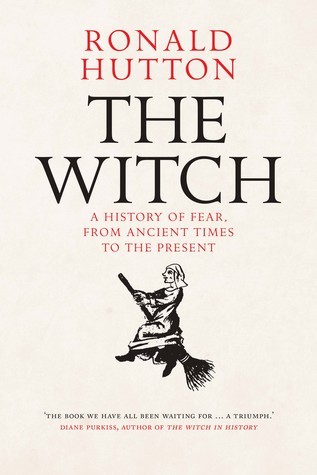

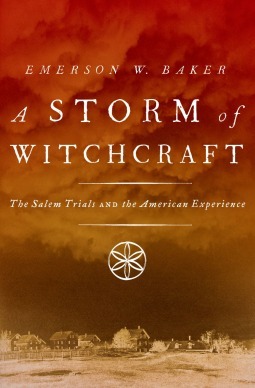

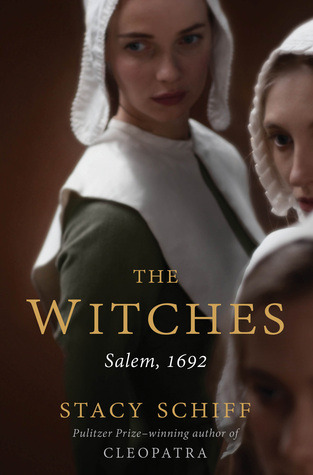
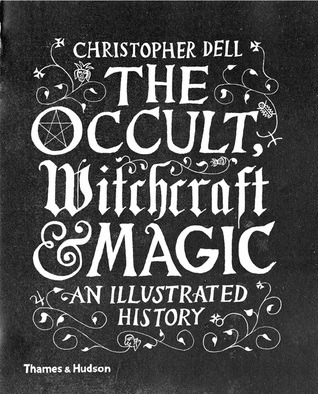
A History of Witches: a non-fiction list
The Witch: A History of Fear, from Ancient Times to the Present by Ronald Hutton
Why have societies all across the world feared witchcraft? This book delves deeply into its context, beliefs, and origins in Europe’s history.
The witch came to prominence—and often a painful death—in early modern Europe, yet her origins are much more geographically diverse and historically deep. In this landmark book, Ronald Hutton traces witchcraft from the ancient world to the early-modern stake.
This book sets the notorious European witch trials in the widest and deepest possible perspective and traces the major historiographical developments of witchcraft. Hutton, a renowned expert on ancient, medieval, and modern paganism and witchcraft beliefs, combines Anglo-American and continental scholarly approaches to examine attitudes on witchcraft and the treatment of suspected witches across the world, including in Africa, the Middle East, South Asia, Australia, and North and South America, and from ancient pagan times to current interpretations. His fresh anthropological and ethnographical approach focuses on cultural inheritance and change while considering shamanism, folk religion, the range of witch trials, and how the fear of witchcraft might be eradicated.
Witchcraft: A Secret History by Michael Streeter
Witchcraft: A Secret History unravels the myth from the mystery, the facts from the legends. Meet all the witches of your imagination and discover the meanings of their rituals and rites, their lore, and their craft. Discover the significance of their sabbats and covens, their chalices and wands, their robes and their religion. Unlock the secrets of the legendary witches of mythology and folk tales and find out how these early stories influenced the persecutions and witch-hunts of the Middle Ages. Learn about the people who inspired the pagan revival and how their work in literature and magic rekindled the fires of the sabbats across Europe and the New World today.
A Storm of Witchcraft: The Salem Trials and the American Experience by Emerson W. Baker
Beginning in January 1692, Salem Village in colonial Massachusetts witnessed the largest and most lethal outbreak of witchcraft in early America. Villagers—mainly young women—suffered from unseen torments that caused them to writhe, shriek, and contort their bodies, complaining of pins stuck into their flesh and of being haunted by specters. Believing that they suffered from assaults by an invisible spirit, the community began a hunt to track down those responsible for the demonic work. The resulting Salem Witch Trials, culminating in the execution of 19 villagers, persists as one of the most mysterious and fascinating events in American history.
Historians have speculated on a web of possible causes for the witchcraft that started in Salem and spread across the region—religious crisis, ergot poisoning, an encephalitis outbreak, frontier war hysteria—but most agree that there was no single factor. Rather, as Emerson Baker illustrates in this seminal new work, Salem was "a perfect storm": a unique convergence of conditions and events that produced something extraordinary throughout New England in 1692 and the following years, and which has haunted us ever since.
Baker shows how a range of factors in the Bay colony in the 1690s, including a new charter and government, a lethal frontier war, and religious and political conflicts, set the stage for the dramatic events in Salem. Engaging a range of perspectives, he looks at the key players in the outbreak—the accused witches and the people they allegedly bewitched, as well as the judges and government officials who prosecuted them—and wrestles with questions about why the Salem tragedy unfolded as it did, and why it has become an enduring legacy.
Royal Witches: Witchcraft and the Nobility in Fifteenth-Century England by Gemma Hollman
Until the mass hysteria of the seventeenth century, accusations of witchcraft in England were rare. However, four royal women, related in family and in court ties—Joan of Navarre, Eleanor Cobham, Jacquetta of Luxembourg and Elizabeth Woodville—were accused of practicing witchcraft in order to kill or influence the king.
Some of these women may have turned to the “dark arts” in order to divine the future or obtain healing potions, but the purpose of the accusations was purely political. Despite their status, these women were vulnerable because of their gender, as the men around them moved them like pawns for political gains.
In Royal Witches, Gemma Hollman explores the lives and the cases of these so-called witches, placing them in the historical context of fifteenth-century England, a setting rife with political upheaval and war. In a time when the line between science and magic was blurred, these trials offer a tantalizing insight into how malicious magic would be used and would later cause such mass hysteria in centuries to come.
The Witches: Salem, 1692 by Stacy Schiff
The panic began early in 1692, over an exceptionally raw Massachusetts winter, when a minister's niece began to writhe and roar. It spread quickly, confounding the most educated men and prominent politicians in the colony. Neighbors accused neighbors, husbands accused wives, parents and children one another. It ended less than a year later, but not before nineteen men and women had been hanged and an elderly man crushed to death.
Speaking loudly and emphatically, adolescent girls stood at the center of the crisis. Along with suffrage and Prohibition, the Salem witch trials represent one of the few moments when women played the central role in American history. Drawing masterfully on the archives, Stacy Schiff introduces us to the strains on a Puritan adolescent's life and to the authorities whose delicate agendas were at risk. She illuminates the demands of a rigorous faith, the vulnerability of settlements adrift from the mother country, perched--at a politically tumultuous time--on the edge of what a visitor termed a "remote, rocky, barren, bushy, wild-woody wilderness." With devastating clarity, the textures and tension of colonial life emerge; hidden patterns subtly, startlingly detach themselves from the darkness. Schiff brings early American anxieties to the fore to align them brilliantly with our own. In an era of religious provocations, crowdsourcing, and invisible enemies, this enthralling story makes more sense than ever.
The Occult, Witchcraft and Magic: An Illustrated History by Christopher Dell
From the days of the earliest Paleolithic cave rituals, magic has gripped the imagination. Magic and magicians appear in early Babylonian texts, the Bible, Judaism, and Islam. Secret words, spells, and incantations lie at the heart of nearly every mythological tradition. But for every genuine magus there is an impostor.
During the Middle Ages, religion, science, and magic were difficult to set apart. The Middle Ages also saw the pursuit of alchemy—the magical transformation of base materials—which led to a fascination with the occult, Freemasonry, and Rosicrucianism.
The turn of the twentieth century witnessed a return to earlier magical traditions, and today, magic means many things: contemporary Wicca is practiced widely as a modern pagan religion in Europe and the US; “magic” also stretches to include the nonspiritual, rapid-fire sleight of hand performed by slick stage magicians who fill vast arenas.
The Occult, Witchcraft and Magic is packed with authoritative text and a huge and inspired selection of images, some chosen from unusual sources, including some of the best-known representations of magic and the occult from around the world spanning ancient to modern times.
#nonfiction#non-fiction#witchcraft#witchcraft books#the history of witchcraft#tbr#Reading Recs#book recs#recommended reading#to read#library#public library#history books#history
132 notes
·
View notes
Text
The reunion with someone you love, thanking someone who was unrewarded, saving of the pitiful who cry for help: universal themes in events and their connection to Roman and Olga
Benienma's charming New Year event ended and there were lots of good moments. Specially for Fionn fans who finally got their favorite to take the spotlight. Fionn is in Ireland, the equivalent of King Arthur, just like Cu Chulainn is the equivalent of Herakles, so the way FGO has handled him was horrible so far but he came around in this event and got impressive feats on his own. But I won't talk about Fionn, others have done before this. When this event dropped years ago, I and a lot of japanese players felt certain uncanny emotional parallel with Beni's old man and Mash's situation with Roman. A man who never knew happiness for themselves and always thought about the happiness of others, cloaking themselves in big lies, misunderstood alive but grieved in death. Who still died smiling because others were saved and happy, yet still they want to thank them and set things right, even if it's an impossible wish.


Mash is the one who speaks up, while she doesn’t overtly voice her parallel, we know it exists.
If I am to only fulfill my role between larger gears,
There isn’t much to worry over,
If “only” is good enough.
I’d like to try living, in the time I was granted.
I don’t fight to suffer,
Just like you said.
Please, let the gentle rain fall upon me, upon our will.
When I depart, I’d like for you to quietly see me off.
When I was done crying, I could no longer hear your voice.
That’s how you urge me on, I see, telling me that there’s no road back.
I was born into this world to live.
There is no other definite reason.
I don’t need a mission or a meaning.
I will live! I don’t want to
Let my memories with you end in sorrow.
Just like you said,
The conclusion can be repainted, always.
Cut for length.
This is the song for her mental and emotional state after what she lost at the end of part 1 (Roman). It’s called Blank Space, it shows that, like Benienma, she’s continued her duty for the chance to see Roman again. This post isn’t about Roman, but also about Olga, since the prologue of Part 2 there are two heavy losses that weight Mash’s heart (also the player but Mash’s more vocal about it): first is her guilt of being unable to save Olgamarie (which was discussed and was the reason they went to save Goredolf) and the other is her sorrow with the separation with Roman whom she didn’t even properly thank for everything he did for her (was hinted how she is comforted by his room in Missions before being tore apart from it in the prologue where she had a breakdown and refused to leave). Events in FGO sometimes don’t exist in isolation, they connect to major plot arcs: Ooku continues CCC and is about the major plot of the Beasts, for example, Oniland and Christmas 2020 with Karna supply dragon lore which surely will be important in Britain Lostbelt or when Arthur confronts the Beast of Revelations. Plenty of events to build the Greek Pantheon and characters. As such, there are these small emotional catharses of events that are sometimes connected to the main characters (Mash and Guda) own desires and wishes. The desire of Guda meeting the one(s) he loved and lost again is ever-present, even in interludes:
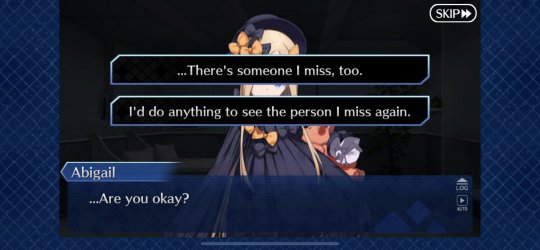
(Abigail interlude)
The person singled out for this is always Roman. Aphrodite's song illusion in Guda's heart led toward Roman and is a mere possibility he was around (even without a blank without body, even without understanding what he's saying) what broke in Guda's defenses. It was always when they gave in about the doctor when the loop was allowed to continue. It was also the source of strength to break out of this. Because Guda can't face Roman unless they are proud of their answer and path, in death or life, they can't thematically meet again (exceptional events aside) until Guda is satisfied with their actions. Events sometimes feature this Roman-loss theme, or rather about being reunited with someone you separate from and lost what is the conclusion of one's journey: Sitonai reunites with that Berserker in Oniland, Beni with the old man, and there's that movie singularity that was all about a man who was misunderstood and made a villain by people who after his death realised their mistake and understood he loved his foster daughter's future and would protect it with his life. Mash was personally touched by that script (so was Roman, who was included by Nasu changing the original novel that was going to be published, to help the cast reshoot the movie for Mash's sake) and wanted to ensure to preserve it, the end of the movie is the daughter living well while the father is watching over, apparently alive, but with a different appearance who one day might meet his daughter again.
The other point of emotional struggle is to help or save those who pitifully want to be saved. While the reunion is nearly always involving a man (sometimes a father figure or someone who was a guardian), the saving part is almost always about a girl, usually, a girl who is doing evil actions and needs to be put down for the sake of others but Guda and Mash (if she’s around) refuse. Imaginary Scramble features two of them: "Gogh" (Clytie) and Yang Guifei. The Olga factor goes tacit in all but the male exception, Goredolf was a man, but the Olga connection was brought up explicitly in his case. This plot-line might have started with Ereshkigal Christmas event and Salem (on that note, Abigail's search and longing for her dead friend also connect and echos with Guda's losses). This started after part 1, because during Observer, those who were twisted or darkened or made villains were disposed of instead of saved (Ushiwakamaru in Babylonia for example, or all the Servants affected by madness in Orleans). Because it was not important during part 1, but it is for part 2.
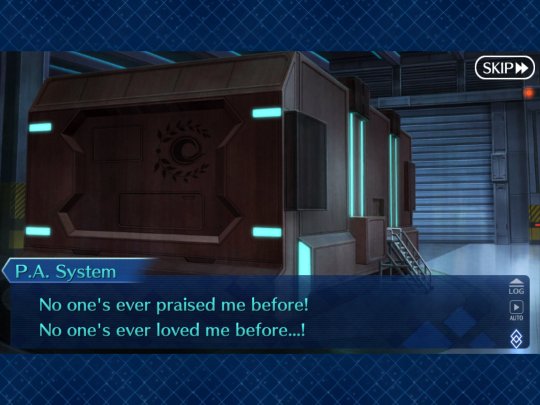
(in a nonsubtle way).
IMO, the Greek Lostbelt was also a climax to voice what Mash’s (and Guda’s) wants. Mash finally breaks out and says she wants to meet Roman again and thank him for everything after the Person of Chaldea appears. They aren't speculating about his identity or his warnings, rather they are emotional about how he can't be the Doctor because his eyes are different and wish to meet him again in an emotional My Room scene. Olympus was for Olga, after U Olgamarie appears and they are left confused by her actions, that is Olga but she's their enemy, a Beast, but still they want to help her. Because that's always been one of their biggest regrets. Greek Lostbelt kicks the course of their personal emotional catharsis arc: Olga is there, but she's an enemy; an ally who resembles Roman appears but he's not their doctor. Man of Chaldea and U-Olga have the same function: to be different kinds of emotional hurdles Mash and Guda face, aside from their role in the plot (obviously they are more important than just angsty plot devices). So it begins their personal goal: meet Roman again, save Olga. Atlantis and Olympus also have a little of both. Olympus with that dream which had an emphasis Guda's feelings toward Roman, among all their losses, while Atlantis with the subplot of Corday and the nanomachines (which the priestess witnessed).
To wrap up, this is merely tangential, but this scene was translated at last, so I might give context to those who don't know it:
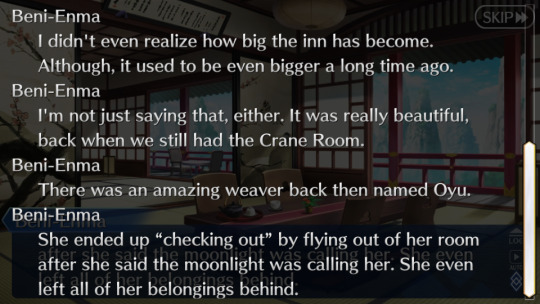
This weaver is "Miss Crane", who appears in Waltz in the Moonlight Lostroom, a special game released on anniversary with the plot by Nasu. Just to show how tied is Roman's story and Benienma's event narrative. The doctor created the Moonlight Room, that became a harmless singularity that exists linking past and future, similar to the Inn. Crane manages it by his request and one of Crane's goal is to reward him, even with the little she could do for him. Roman gets the broadcast of the Ball Crane arranged for him in the game’s ending. This foreshadowing that leads back to Roman was included in the same chapter Beni tells us her backstory and her wish to thank and meet that man again. And she did, in the very end, as a personal reward for her efforts, and his.

(Fate/Grand Order is a story of many meetings and departures, and meetings again).
Note that because I interpret that Mash’s and Guda’s emotional catharsis arc require: needing to help Olga (to exercise their regrets), and meeting Roman in the end (as reward), it doesn’t mean that Olga or Roman will be alive or playable in the end. Olga could sacrifice herself as Corday or Ophelia did after being saved (her choice is going to be important, because it seems build up for her to finally make a stand she wants), Roman can be met in a death-state or in the Lostroom/Moonlight room as connection of past and future. It’s just that those things needed to happen for the emotional closure and they have had a built up before the Greek Lostbelt.
40 notes
·
View notes
Text
Call of the Wild
It isn’t very often that I play downloadable content (DLC) for video games. Most of the time, they’re senseless cash grabs offering outfits for characters, or come out six months or a year later when I’ve moved on to the next bombastic title. Another reason for why I don’t usually play DLC is because I’ve already traded in whatever game title it was. Madness, I hear you say. But hear me out first before you make any harsh judgements.
After years of when I had games piled nearly to the ceiling, my mother decided that it was time for me to declutter. What’s worse, there were plenty of titles that I never felt the itch to replay in the interim. With so many titles sitting on the horizon, trying to get through them all is a slog. Considering how completely I finish most games, my interest almost always flags as soon as the credits have rolled. Why? Because I’ve done all the side content and explored nearly every inch of the game world.
Marie Kondo said it best. If it doesn’t spark joy, get rid of it.
I will admit that there are a few games that I’ve kept. Some for nostalgia, others because they’re pretty rare and few between. Most of them are Japanese role-playing games (JRPGs) or are somewhat niche titles.

When Sony had their Play at Home initiative several months ago, I picked up the complete edition of Horizon Zero Dawn. Though I enjoyed my time with it and am eagerly anticipating the sequel, I did not think to keep it once I received my platinum trophy. Instead, I traded it in and used the meagre amount I received from EB Games to reduce the price of my next game.
Coming back to a game is difficult when you’ve played so many others in-between. While I still remembered the overarching plot, it took a while for me to relearn the controls. Almost always, I’d press the wrong thing and Aloy would crouch instead of dodge or do something else just as asinine.
It reminded me of the days when I used to switch between the games I played back in my youth. And almost every time, I’d restart because I couldn’t follow the narrative thread or the skill level where I had left off was simply too high for me to pick up again after I had grown rusty.
After bumping the difficulty down, I took my time to finally play through the DLC that I had never been able to enjoy: Frozen Wilds. Though a short piece, it provided a whole new area to explore and another wild story about rogue AIs that are threatening mankind from populating the Earth. Though I doubt much of the plot will have a major impact on what is to come in Horizon: Forbidden West, it also helped shed some light on the ever-present dangers and the lore of the world Guerrilla Games have carefully constructed.
As with the original title, I loved how much care was put into crafting the stories for those that came before. Even better is how the developers have tried to interpret how the Banuk, Carja, Osham and Nora tribes interpret the things around them and adapt to the post-apocalyptic world that they live in. And while the things Aloy finds makes sense to us, the players, it’s not as clear cut for the people of the world.
One scene that stood out for me was where a Banuk man mistakes Montana Recreations as an actual person rather than a company.
It’s these little things that make it so incredibly fascinating when it comes to how many of the things that we take for granted in our current world, don’t always make sense to an outside observer. What are these ceramic holders for? For what purpose did the old folk use these rectangular objects with the shape of an apple on one side and a black screen on the other?
As someone who has enjoyed ancient history and the myths that previous cultures used to help explain the world, the work that has been poured into archaeology and anthropology is something that I greatly appreciate. Its replication in video games that are set in the far future is also a great way to look back and see how far humanity has advanced.
Though the story of a rogue AI subsystem is not new, Frozen Wilds adds a little more context to the ongoing struggles that Aloy will face. With Horizon: Forbidden West quite literally on the horizon, I’m eager to see where this franchise will take us. I do hope, though, that we might see something beyond the very much America-centric nature of so many video games (but I’m not going to hold my breath).
In regards to the new enemies the game introduces, I thought these were moderately exciting to encounter. Given how long it has taken me to pick up Horizon Zero Dawn again, even the old enemies gave me the same trouble because I forgot all their weakness and which arrows could best be used against them. Thankfully, it wasn’t long before I had figured it all out again and could hold my own amongst the foes Aloy faced.
Overall, I enjoyed my time dipping back into the world of Horizon Zero Dawn. If nothing else, it made me all the more excited for Horizon: Forbidden West. Now, if only we could put a stop to COVID-19 and the rampant Delta strain, I’d be happy.


3 notes
·
View notes
Note
How was your element of harmony fic gonna end?
OOH NOW THIS ONE HAS BEEN SUCH A WHILE THAT THIS ACTUALLY SOUNDS FUN TO TALK ABOUT
Context for those unaware: EoH was one of my many attempts at a multicrossover. A predecessor to TBTC. It was my goal at being an EVERYTHING CROSSOVER and taking forever to highlight every little thing that could be explored in the canon of each work used. And I was in a difficult relationship with KH at the time, even though it was obviously a KH derivative, so I didn't want to actually use Sora and co. as the main cast. MLPFIM was a comfort show for me, and I was already used to the br0n135 using the Mane Six in crossovers with everything you could imagine, so I was like, hey, let's do this, Mane Six are now multi-world travelers and Discord is assembling every villain ever to stand in their way. (KH then ended up in the mythos anyway!) This is also where I was playing the infamous Twilight Sparkle/Mozenrath ship that is now very very dead.
To explain exactly what all was going on with the lore and politics of it to make this last bit make sense would take too long, so from there, please just...roll with it. I'm about to detail you THE FINALE ARC
The original idea was actually, at some point, to begin work on the Finale Arc when most of the main players were introduced. Then go back in time and keep editing the middle of the story to go on indefinitely. A bad business plan for many reasons, first of all being that I didn't even get to introduce the players that would've made it possible to begin the arc. That's how long I took to explore EVERY FRICKIN THING.
Over the course of the story, Discord has been interfering on every crossover world you can imagine, to the point of sometimes altering their canons into "fix fic." The story is aware of this. It's kinda like in the Loki series (of which I've only watched episode 1) where there's a "sacred timeline" and Discord's crossover actions are deliberate attempts by him to break it. We learn at some point that paradoxes and timeline changes are what broke the Age of Fairy Tales into the KH worlds we know today. So Discord rounds up his Old Ones (the Lovecraftian monstrosities that are more powerful than gods) and they all band together to strike at all the cracks he's put in the structure of the multiverse, and it all just falls APART. Worlds are destroyed, time has no meaning, suddenly everything is shards floating in void. The main players survive, mostly. Countless civilians die. Some named characters are given tragic deaths.
I've actually written one little snippet from this arc because I wanted to. It details two particular characters, who at the time were side villains I enjoyed and was just digging the vibe of, going down defending a stronghold from the creatures of Darkness (oni, yokai, Heartless, Grimm) that emerged from the void when everything broke. By the way do you want to take a guess who these characters IT WAS ARCHIBALD SNATCHER AND ROMAN TORCHWICK. GOD, THAT SHOULD'VE BEEN THE SIGN RIGHT THEN AND THERE THAT THEY WERE WHO I WANTED TO BE WRITING ABOUT FULL-TIME
But! I had a friend who'd lent me the book "Haroun and the Sea of Stories," and I was REALLY into that book's whole concept of "all stories in existence are threatened to end." So I lifted Khattam-Shud, a personification of The End (and I have since heard is also a political caricature), as the ACTUAL final boss. Discord wanted to blow up the multiverse because of the CHAOS that would ensue! KS, however, wanted to end EVERYTHING. (If I were doing this today, he'd just flat-out be Ansem, Seeker of Darkness instead.) Discord would realize he'd been played as KS makes a bid to line up one more cataclysm that will reduce everything to dust.
Heroes and villains alike, Discord included, find each other across the wastelands and amass into one last survivors' army led by the Mane Six. They approach the final field standing between them and KS and they charge. KS unleashes Dark creatures (Echthroi, as I had it) to gun them down. Pretty much everyone dies in this battle except the Mane Six themselves. (Which should give you a hint as to how this REALLY ends, but let's keep going.) The Mane Six fight their way to KS (and I'm REALLY gonna date myself here - the final line of defense before him was gonna be Paige the freaking Notebook from DHMIS as a personification of creative control). He shatters the Elements and then un-exists the Mane Six, but they don't die.
Instead, they end up in a sort of...white realm, inspired by the development rooms in The Stanley Parable (I was into even weirder fandoms back then than I am now apparently?). At one point it was gonna be "inside the author's laptop" and they could see doors to other timelines (i.e. crossover fanfics my friends were doing). They can also see all the files here for all the worlds they visited on their way and all the friends they made. Y'know, everything that's now DEAD.
The memories of everyone and everything they loved, however, allows them to forge one (1) new Element stone. This is...wait for it...THE ELEMENT OF HARMONY. Its surface shimmers with a rainbow of all colors! But wait! When it's flipped over, there's another side to the same gem, with colors dissonantly swirled around in an ugly way. Our heroines realize that the Element of Harmony also serves a dual purpose as the Element of Chaos, since you can't have one without the other!
The Mane Six find a way back to KS' battlefield, where he's about to finally UN-EXIST EVERYTHING. Twilight gets to say the one and only "FUCK" she's allowed to say in the whole story (I really...want to use this same joke on Mozenrath in TBTC...I know I've said he curses inaudibly to keep him IC but just imagine in the finale arc he gets the one and only FUCK he's ever allowed in his life). The six huddle around their Element of Harmony and activate its magic, casting a rainbow aura that begins to heal the broken multiverse. KS then tells them there's no way that will ever work because he and the other Old Ones caused so many paradoxes that it'll fall back apart again. To build a multiverse that's stable under these conditions would make no sense. And Twilight goes "WHAT FUN IS THERE IN MAKING SENSE" and flips the Element over to the Chaos side! Now the Chaos energy basically...fixes all the plot holes and physical impossibilities of the multiverse, allowing it to rebuild everything that had broken without a single issue!
Discord petrifies Khattam-Shud and it was fairly badass but I can't remember exactly what one-liner I gave him to end it.
Lights up on a rebuilt multiverse. Everyone's alive again and nothing's broken! YAY! And everyone in the survivor army (though they're not "survivors" anymore since EVERYONE is alive again) has come to Equestria to give the Mane Six a celebration for saving literally everything! AND THEY'RE ALL PONIES OR OTHERWISE MAGICAL CREATURES BECAUSE OF MY RULES OF FORM CHANGING IN THAT FIC. HAHAHAHAHA IT WAS A VERY COMICAL MENTAL IMAGE AND STILL IS.
The Six get their ships (Twilight/Mozenrath, Pinkie Pie/Megavolt, Fluttershy/Sakuya from Okami, Rarity/Stork, Rainbow Dash/I would really rather not say this one because it was taboo in a way I don't wanna touch again, Applejack/I don't even know anymore because it was gonna be Emma Swan and then it wasn't and then I just got confused). And everyone just has a good time.
The Six then take off in the ship again for THE ADVENTURE CONTINUING, EVEN THOUGH AFTER THIS I WOULD JUST GO WRITE ETERNAL ADVENTURE LEADING UP TO THIS MOMENT
Also I heard the song "We Come Running" by Youngblood Hawke on the radio once and I was like "This would go great over a credits sequence" so I used it for a while as my inspo for a KH-style "credits montage" where you see each of the most major worlds and the factions that live on them, and an early concept for the WHAM ARMY was one of these factions and this cracks me up so much because they graduated from a shot in the KH montage to WE ARE THE PROTAGS OF THE NEXT FIC
And that's pretty much it!
#eoh#elements of harmony#i hope you enjoyed this fucking crack shitshow#anyway. watch me pretend this is old news and then#DO THIS EXACT SAME ARC WITH ANSEM IN TBTC -#don't worry it can't supercede the eraqus shit
2 notes
·
View notes
Text
Assassin’s Creed Unity Review/honest thoughts/discussion - SPOILERS (long post)
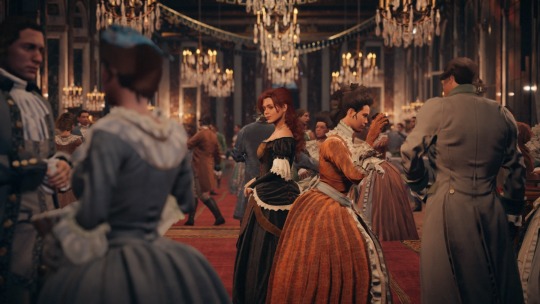
So I decided to finally settle on a proper review – although this one is going to be more of what here in Argentina we call a "sincericidio": basically I will spit my guts out and cry in one corner, while being completely honest about my feelings. I will try to keep most spoilers at bay, like I always do, but there's just one thing I cannot not talk about which is THE spoiler so – I want you to be considered warned.
Before I start, I should state, since this is my review and reviews are quite personal actually, why this game is so important to me and why I wanted to play it so bad. There's a combination of factors, and obviously this game isn't going to strike the same chords with everyone, so bear in mind that this is strictly subjective and, right now, personal.
First factor and I think the most important one: I like writing. Wait, don't leave the review just yet. I like writing and creating characters. I have many. Lately I've been revisiting a character that had a very sad backstory and added quite long happy ending for him. I made him fall in love again. He's black haired, wears a short pony tail… his new love interest is a redhead with wavy hair… ok, you get me now, don't you? And what's worse, is that their story takes place in a fictional world that resembles quite much Europe of 1800's. So clothes and ballrooms and palaces and big, fluffy dresses are a thing in this story of mine. I think that, if you've ever created a character, to find another fictional, similar character in any medium is going to draw your attention to that product right away. It did happen to me with Cal Kestis from SW Jedi: Fallen Order, I have another redhead baby boy that needs to be protected at all costs. It's a way for us to 'see', let's say, or imagine our characters being brought to life.
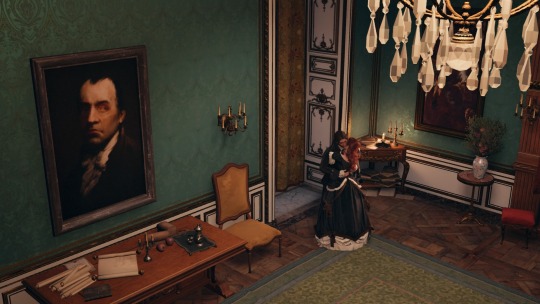
Second factor: I love Paris. I visited Versailles and Paris back in late 2018, and I went there with zero expectations, only to fall in love with France. I love the Château de Versailles. I love palaces. I love the Seine. I love the Louvre. I love it. All of it. If I could, I'd live there. Sadly, I'm poor and speak little to no French at all.
Third Factor: I'm learning French! I dream with the day I can speak like five languages as well as I speak English (I studied it for ten years so… it kinda makes sense that I feel comfortable with it). I'm still struggling with French, but I will get there someday. I will. Because I love it. I love the language. Oui.
Fourth factor: I also really really, really like the French Revolution, and I've never, much to my surprise, watched or played any series, videogame, movie or anything that takes place in such a context (if you have recommendations, please drop them right away!). And I say "to my surprise" because I really like that part of History! So, to live in almost first person how the French Revolution unfolded – to hear the chansons and to see people gathered in crowds at every corner, listening to a liberty preacher wielding the French flag – that was glorious.
Fifth and yeah we're done: I love Les Misérables. I know it happens way later than the French Revolution, but since this musical (and the 2012 movie) became my 'home', I can't help but feel a stronger connection with everything I said above. I can watch that movie over and over and I will still sing Empty chairs and empty tables with tears in my eyes, despite its flaws.
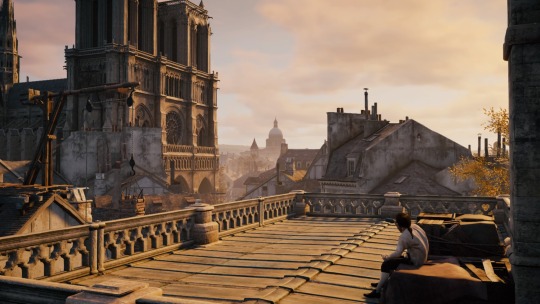
I had like every reason to play this game. And it paid off.
Before plunging into it, I did read the novelization. Sadly, it was only to satisfy my soon-to-be-fulfilled obsession with the game, since I don't think the quality of the narration was, uhm, that good – it felt like you needed to have played the game before reading it. And I get it, it's a videogame adaptation, that's fine, but when you look at it as standalone book, it doesn't stand alone that good. What disappointed me, though, wasn't the narration, which was what I totally expected it to be, nor the dialogues or the ending – it was Élise. I was bit weary about this because she came across as completely different character than what I had in mind about her, and I didn't like her. At all. In the book, at least. I didn't like her because she had a few comments and took some decisions that made her look like she was stupid and/or selfish. I can understand the selfish part; I do not want to even believe that she's stupid. So that's why the book was a bit of a letdown for me. I recommend it, though, if you're a fan, because there's a book exclusive character that really gets the plot moving and he's endearing: Mr. Weatherall. Oh, what a man.
Now, regarding the game itself – it shouldn't come as a surprise that I thoroughly enjoyed it. As I've stated in another post, this game is barely an Assassin's Creed, since you delve like zero into the AC lore, and it's just an excuse for your character – Arno – to know parkour. Which in fact he knows before becoming an assassin, so it begs the question, why is this game even in this franchise? I digress. It's an AC game at the end of the day and that won't change.
But do not jump into this game expecting it be your average AC story. I firmly believe that the creators wanted to convey a different story here. For starters, Arno is no hero. Arno doesn't want to save the world. Arno doesn't care about any artifact or magic or creed. Arno only wants to discover who's the man behind De La Serre's death. That's his main driving force. And behind that, there's this undeniable and yet quite destructive feeling that pulls him forward: Élise.
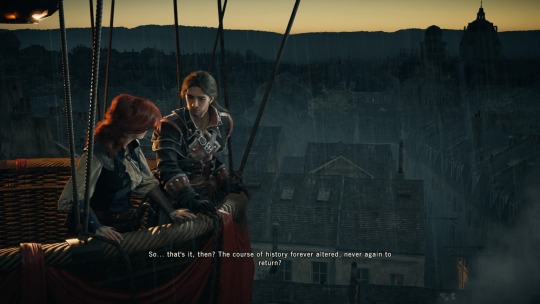
Élise and Arno's relationship goes deeper into this story than it's noticeable at first glance. When you look back upon the plot, you discover that without their love 'subplot', there's no plot at all. If I may be so bold, I would even argue that Arno's story is a tragic love story. All the assassin's lore, all the betrayals, the first few assassinations, it all falls back into the background when Élise returns to the stage almost halfway through the game. And even though they only share like one kiss or two during the 40 hours of gameplay, there's still this latent, persistent motivation behind each of Arno's actions, that he wouldn't be doing what he's doing if it wasn't for Élise.
And it all comes down to that one line: What I wanted was you.
I cannot stress enough how much I loved all of the drunkard memory of Versailles. I think it embodies Arno's perfect character development. The constant rain and the bluish filter on every framerate added to the overall depressing atmosphere. I felt miserable while playing those quests, and the moment he steps out into the entrance of the Château de Versailles and reflects on his past decisions – decisions that have been stolen from him, because he could never defend himself nor change the course of actions on his own accord – that exact moment that he sits down and cries, I cried too.
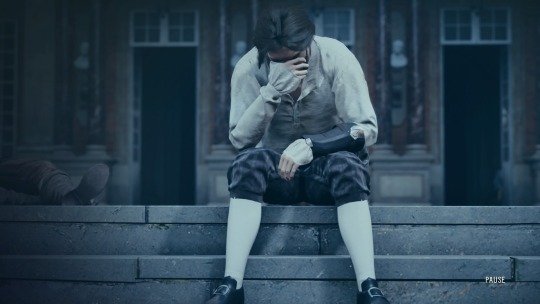
Because all the game, all the memories, all the dialogues go in a crescendo only to crumble into this abyss. And this, in turn, creates a fleshed-out character, with a believable development, believable feelings, believable motivations. I can feel for Arno, I can understand him, I pity him, and I want to hug him. The whole game reaches its peak in its main character's worst moment: when he realizes that he's screwed everything up.
And not always do we get a story where the main character doesn't win. He just doesn't. Underneath its revolutionary streets, this story reeks of inexorability and fatality. You know it, you know it in the back of your head, but you push that thought apart because you want to enjoy jumping over rooftops and finding the best strategy to kill that man. There's this underlying, looming melancholy in every memory that you play in, and that's why the end doesn't surprise us.
It makes us cry, of course, but it didn't come as a surprise at all. If you're shocked about the end, then you haven't been paying enough attention to Élise's dialogues, to the tone of the story, to her letters, to where this plot was going. Because, like I said, the story is about Arno and Élise's relationship, it isn't about defeating the bad guy. And there was only one way that story could end.

*cries in French*
*Je pleure beaucoup*
I know the game has been panned by players for its performance. And being the 2020 year of our lord, I cannot say I reject those allegations, since it's been 6 years since the game was released. I hope enough patches were implemented to salvage the bugs. I only came across one bug in my entire playthrough which bothered me a little: some NPC's would sometimes pop into cutscenes and phase through the characters like nothing. At first it was funny, but then towards the end it happened two more times, in important cutscenes with our lovely couple, which kinda destroyed all immersion, if you know what I mean. The rest was fine: it never crashed on me, I didn't encounter the infamous, horrendous bug that unleashed memes in internet, never a T-pose or something that rendered the game unplayable – nothing, only that funny bug I mentioned. I did see the drop in framerates, specially in very crowded areas – but to be honest I never saw a game with so many NPC's together in the same place, like, hundreds of them, each with unique animations and varied models. I only come from playing Syndicate, and even there the number of NPC's was lower. Here is jarringly unreal, I didn't know the French Revolution was THIS jam-packed with people!
On a graphical department, this 2014 game still holds up. Very well. I think it even looks better in some scenes than some of its successors. The cutscenes were sometimes very cinematographic, with close ups, zoom outs, certain angles, with quite real lighting and shadows. I know it's not Naughty Dog and it doesn't have the whole Sony battalion behind, but damn if some of the character's expressions were really good. It didn't happen often, so when one of them had this very specific face I was like *insert surprised pikachu meme*.
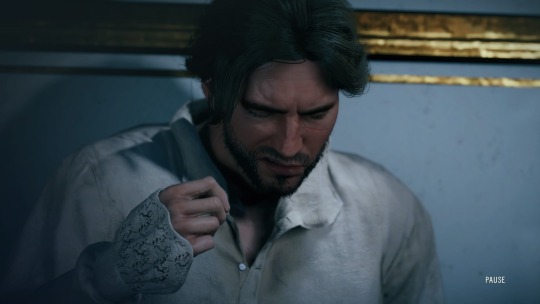
I also enjoyed the music a lot. I don't know why but the one from the main menu stuck with me for a while. All of the songs have this Versailles, aristocratic tone to it which put me in the mood.
I have only one minor complaint and its entirely optional, let's say – I want to platinum this game. But I don't own PS plus, because it's, uhhh, expensive in my country (do not want to indulge in dollar exchange rates right now). And there are like two trophies only obtainable through multiplayer, which renders my trophy hunt useless. But, alas, I knew this before buying the game. I think that games shouldn't come with multiplayer trophies for the platinum. If you have to pay extra for something, it must be completely optional. And so should be the trophies related to it. It's a bit disappointing, though, because after finishing this game I want so bad to return to it, but if I can't platinum, I don't see myself coming back to it soon. Either way, I could still earn the rest of the trophies, but that would only enrage me more when the last 3% is going to be locked forever *cries again*.
All in all, my major question at the end is: why does this game receive so much hate? I guess if I came from a hardcore fan standpoint I could understand it more. If I had played all its predecessors before this one, I would also feel that the gameplay and the objectives are repetitive. That the challenges are bs. But the stealth aspect has been improved, the parkour has been redesigned and adapted, and as of now, bugs aren't a problem anymore. I want to believe that when a remaster for the PS5 comes out or, I don't know, if someone by divine grace has an epiphany in the near future regarding this game, people will change their mind on this one and will appreciate more what it wanted to be, than what they made it to be. After all, this is Arno's story. Arno's tragic love story.
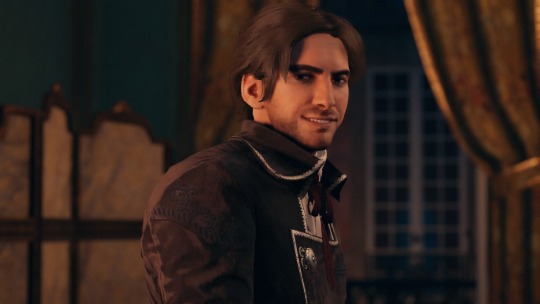
Also this game is beautiful JUST LOOK AT IT LOOK AT IT!!!
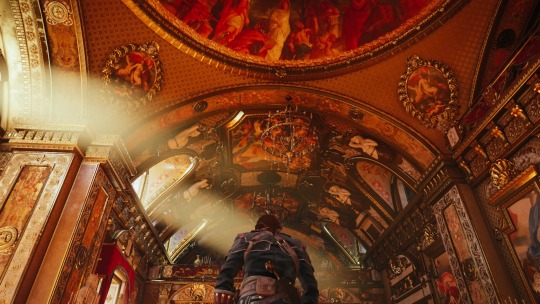


Sorry couldn’t help myself
#assassins creed unity#assassins creed#ac unity#arno x elise#arno dorian#arno victor dorian#elise de la serre#assassins#templars#review#videogame review#ubisoft#assassins creed syndicate#germain#play station 4#rant#long post#versailles
65 notes
·
View notes
Note
Hii MJ. I was wondering what you think of the possibilities of Zevran being in DA4? Ik bioware has brought back a character from the dead (Leliana), so Idk if I’m delusional for ignoring that zev can die. But considering he (used to?) be associated with the crows and they seem to be a big part of the next game, do you think it might be possible that he could have a conditional advisor like role? Or since he isn’t a crow, he definitely won’t be?
Hi Nonnie! Some thoughts on this. This became long so it’s under a cut. TN spoilers under cut.
Initially on seeing the BtS vid I wondered if one of the Crow figures could be Zevran (gut response). I don’t think it is anymore. That figure’s outfit resembles Zevran’s “Black Shadow” attire from WoT, but lots of characters in the concept art are wearing various types of Crow uniform: the other character in that picture is also wearing Crow clothes, and so are figures here, here (Matt Rhodes’ Art Station upload of this one says that “Crow” is the title of that piece) and here. Assassin-y figures are also present in the lineup shot. I think what it means given the ‘concept art is mood-setting’ stuff is that the Crows as a faction will have a significant role to play in the upcoming game. This makes sense given the prominence of Crows in TN - no less than 3 stories, one of which introduces in-depth a new significant-feeling Crow character (Lucanis, who is currently active in Tevinter, who pinged ‘companion flags’ to me [this is subjective tho], and whose short story ends with in unresolved “unfinished business” Tevinter-heavy hook) and one of which expands at length on known Crow lore as well as being like “here’s what’s been happening with Crow leadership and here’s some setup for what’s going on with the Crows soon due to the Antaam invasion”.
They did bring back Leliana if she was killed in DAO (demon pope!). I might be misremembering, but I seem to remember some tweets or other dev comment somewhere where they said that they’d try to avoid bringing back player-killed characters like this in the future (could def be remembering this wrong though). I also think I remember PW saying that when writing Trespasser, the Bull dying if you sided with the Qun in his DAI mission thing was something they struggled with a lot over whether to have happen or not - because having that happen would mean that in those universes, Bull is dead-dead and that could potentially have knock-on impacts if the writers ever wanted to use him again in the future. There are other cases where dead characters resurface, like Anders in DA2 (but his potential death in the expansion was an epilogue slide, and the epilogues are framed more as rumors and many chunks of them have been retconned in subsequent games) or in the extended media (e.g. Wynne popping up in Asunder if she died in DAO, but we know that the stories in the books and novels aren’t canon-canon, that being a limitation of the media-type where it’s not like you can enter or make choices, but that they are events that fit in BW’s ‘default’ canon, and that the events described therein unfolded in a different way in different universes like in ones where Alistair isn’t King).
The explanation for Leliana’s survival was a highly specific, rare set of circumstances - the devout Andrastian woman who died in a magic mountain full of lyrium which does kooky things, who believes maybe the Maker brought her back. How many lyrium ghost spirit-imitations of dead chars are walking around Thedas, or should be implied to be? The writers can always handwave, retcon, or explain around anything that they choose to, and if they want to bring him back in all universes they will, but I lean towards preferring “player-killed characters stay dead” because of choice and consequence and enjoying that choices have weight and impact. I also think “surprise, they lived” can become overdone as a gimmick if writers aren’t careful (generally speaking, not a DA-specific comment). For me - what would be the explanation for his survival? He can also die at more than one point in DAO. I know he’s beloved and can also be still alive, but possible deaths aside, when it comes to characters returning in this franchise, especially former companions, I also always lean towards “less old, more new” and towards “a few cameos only, not lots, and such cameos should be plot-relevant, not random”. There are a couple reasons for that which I won’t really get into here as that’s a separate topic, but it’s partially due to feelings like - Thedas is a big big place with heaps of people in it, I prefer it when the world doesn’t feel small, DA is the story of the setting rather than any one PC or group, I’d rather meet and encounter mostly-new people, etc.
Aside from that stuff, aside from Antiva, he hasn’t been positioned recently as being in the north or having ongoing plot-stuff there (this isn’t a requirement for him to come back, and it happening for a character doesn’t mean they’re a shoe-in, but compare that with Fenris in Blue Wraith, who is now in Tevinter and working with Inquisition agents). He’s appeared in 2 games already and been referenced in all 4. I really enjoy what I’ll call his ‘romanced epilogue’ as an ending to his story too - unlike the other 3 DAO LIs, he accompanied his love on their quest to the west in search of a cure for the Calling. I love that, it’s so faithful and romantic. He’s still at their side and they’re still together after all this time. He journeyed far into the dangerous unknown with them looking for a needle in a haystack so that his partner doesn’t have to die a horrible early death, as faithful in his actions as his sentiments that he’d storm the Black City at the Hero’s side if he had to implied. The last time we heard from the Hero and romanced Zevran, they were together, and they were well. Y’know? I also tend to assume, due to Lelimancing Wardens returning in the Trespasser epilogues, that all Heroes who survived DAO return from their quest. I don’t want that to be jeopardized, and those references are enough for me.
And as much as I love Zevran (and I really do), I don’t personally feel a need for him to return either, neither in terms of his arc, ‘exploredness’ as a character, or in the overarching plot. As you say, in some universes he’s not a Crow anymore. There was a cool post I saw on this recently which I’m struggling to find the link to, but the jist of it was that the Crows are a pretty shit organization in terms of their ‘recruitment’ and training practises, how they operate and everything. They abused him during his life and he has now freed himself through his experiences during the Fifth Blight with the Warden, and in this new life he’s been on a years-long endeavor to kill Crows. For Zevran’s future, I think I’d like it if it didn’t always have to involve Crow involvement or a Crow focus? Like, that he’s more than a Crow, than a former Crow, than a Crow-hunter/opposer. Separate to that, there are also other, active Antivan Crows operating in the north that we’ve not yet spent time with in a game or ever gotten to know as a PC. It’s a big if, but if a character like Lucanis or Teia etc is prominent in the game, as a companion or advisor or contact etc, it might be a bit redundant to have another. This example is flipped around, but like, we had Cullen as an advisor, and he was “the templar/former templar guy”. We didn’t then also have a templar companion. So if we had Lucanis or whoever as a companion, I’m not sure that we’d then have a Crow/former Crow in an advisor-type role too?
It’s not delusional to want to see a fav or loved character again though. :) I’m not one of the people that wants to see my favs in every new entry, I’m largely happy for them to be let be off-screen, see a reference to them here and there (like the War Table, an allusion to or a dialogue line about them), but I understand the wish and get the feeling behind it. And it’s especially not delusional given the context which is that the writers have brought back player-killed characters before!
I doubt they’d have an advisor or advisor-like person be conditional (imagine playing DAI without Leliana and Cullen if they died or had unretconned bad endings prior to the game, it wouldn’t work without Padok Wiks-style stand-ins or a lot of logistical work on the devs’ part to structure the writing around their absences in those instances). A conditional cameo of some description though I could see (something comparable to his DA2 cameo or Nate’s conditional appearance in DA2 for example). Can’t say how likely this is though, especially given that Crow business-stuff could be repped by other newer chars. Maybe if there’s an option to dismantle, sabotage or oppose the Crows he could crop up. I’d imagine any appearance in relation to the Crows would be anti-Crow or “informer on the Crows due to past experience”, not pro-Crow or “the Crow perspective guy”, in universes where he didn’t go back to them anyway. And I’m not saying Zevran was a Talon or that he’s still a Crow or that it’s him, but just while I’m on this subject it brought a semi-related thought to mind, which is that post-TN and the surviving Talons having contacting the heirs to the other houses’ Talon roles, I do wonder who the new head of House Arainai is.
(I include the info on the ‘where I lean’ stuff because I’m sure it colors or biases my responses sometimes).
#dragon age 4#the dread wolf rises#dragon age#bioware#mj replies#anonymous#video games#tevinter nights spoilers#tevinter nights spoiler#tevinter nights#spoilers#spoiler#fenris#the Fenaissance#mass effect#abuse mention#cw abuse#abuse cw#abuse for ts
21 notes
·
View notes
Text
THAT BEING SAID, heres my list of criticisms for CP2077 so far because i’m not just blindly praising it. under a readmore for a few spoilers, one major character spoiler so if you’re playing don’t read this until youre finished with act 1
this isnt bringing into the account of the criticisms console players are talking about bc im on PC, but i completely agree with frustrated console players about launch being a mess.
the fact that they cut you being able to take jackie with you to go meet with meredith is really frustrating. i wonder if they lost time and it broke something because it was in the gameplay demo from a while back.
on the same vein, t-bugs ‘death’ was so sudden and fast that i didn’t even register it as her supposedly dying until v brings it up later in the level. i thought she had just gotten hurt and booted from the program. if she’s actually dead i’m going to be incredibly disappointed and its going to be one of my few genuine sour notes on the game.
the romances are laughably inserted and shouldn’t have even been part of marketing in my opinion. from my understanding it looks like they’re all sidequests and there’s only like four of them total anyways. dont bother if your v isnt into one of the two options they have and just pretend youre kissin whoever you want lol
takemuras introduction was amazing but i feel like i missed a dialog somewhere that explained why he ended up getting chased by arasaka so fast after the events of act 1. i know his motivation but am a little confused about whats going on.
in the same vein, some optional dialog choices don’t actually feel optional if you don’t want to feel like you’re missing context for whats going on. i don’t mean this in a lore way, i mean this in a basic narrative way.
i like that v clearly has their own personality that you kinda tweak and manipulate through your own actions, like with geralt in the witcher series. however i completely understand if people were lead to believe they’d be getting COMPLETE FREEDOM and are let down by the reality of V being a slightly less mailable character. as someone who likes witcher and the dragon age and mass effect series i’m okay with my oc having a pre-ordained personality but marketing could easily have misled people to believe otherwise and thats a totally valid complaint.
i love jackie to DEATH and hes one of the most likable videogame characters ever. however i do wonder sometimes if he suffers from ‘bilingual people don’t talk like that’ syndrome. it can get kinda muddy given how translators work in this universe.
in the same vein i think some of the calls for the game being transphobic or misogynist are overblown but i feel like part of it is the game might not be properly relaying that the overly sexual, violent, objectifying advertisements in 2077 is actually part of the lore and not CD trying to be cheeky ala Saints Row. Its a crit on consumerism and how desensitized the populace of the future gets to hatred, violence, and sex that it has to be overblown to the point of ludicracy. it might not translate for someone who hasn’t taken the time to look into the lore or familarize themselves with the vibe of the series before picking up the game. YES it is incredibly gritty and dark, but thats the point. However I think that fact needed to be communicated better because it just won’t be palatable for some people. Its stuff like this that makes me think we really need content warnings ALA fanfic for... all media, really. its a good idea. i could see the ‘fuckable piece of meat’ line being genuinely terrifying for some people and it comes out of nowhere. I like dark media and content but i don’t know if the game properly conveys beforehand that this is a BLEAK. world. BLEAK.
i also think, unfortunately, its clear the team was crunched and ran out of time for a lot of things they wanted to add into the game. i feel like tying gender to v’s voice was the most elegant solution they had considering all of the voicelines in game. not saying it’s the best solution, but i’m glad they did that rather than tie it to body type or genetalia.
that being said i wish you could have a biotic pussy or dick in this game just bc that would be some cool transhumanism. same in general i wish you could replace limbs or eventually get more cyberware options that changed how you look.
I’m glad they’re gonna fix the epilepsy trigger but I’m also surprised and disappointed no one caught that might be a problem earlier on. I wonder what play testing was like.
Also glad the dev team isnt going to be treated like the new vegas team and they’re getting their bonus regardless of the game’s review score. that’s some stupid bullshit but every publisher does that shit unfortunately.
the fact you cant change your makeup, cybernetics, or hair after the start is dumb and i hope they fix that.
the c key being for crouching AND skipping dialogue is inelegant to say the least. you can fix it in settings for skipping dialogue to be ‘hold c’ but it shouldn’t have been an issue in the first place.
ai definitely wasnt finished and it shows. largely in how theres clearly no AI driving and how cops feel half-implimented.
managing stash is CONFUSING. so is the hacking minigame until you get used to it.
it is a LITTLE apparent that you’re going to go into Cutscene Time because characters tell you to sit somewhere specific. However once you’re in those locked scenes the game is still super immersive and beautiful so it’s not too bad.
i don’t understand why youd buy a car when you have one already and a motorcycle but i’ll still probably shop around for funsies
combat definitely feels floaty but ive played bethesda games and nothing can be as bad as those so its fine for me.
i know there’s more but thats what i have so far. I’m having a great time but those are my Thots.
7 notes
·
View notes
Note
Let's hear it, tell us about Mage
Mage: the Ascension is a tabletop roleplaying game (originally released in 1993) set in the World of Darkness, a darker reflection of the real world where crime is more common, the working class is even further beaten down, and society is more apathetic to the problems of the world. Also, monsters are real, and some of them prey on humanity from the shadows.
Most of the World of Darkness games (including Vampire: the Masquerade and Werewolf: the Apocalypse) focus on playing as the monsters in the shadows, dealing with things like vampire politics or fighting against the cosmic force of decay and corruption. Mage focuses on, well, mages. Within the context of the game, mages are people who become aware that reality is more flexible than most people assume, and by taking the right steps, they can do the impossible through magic. Well, mostly that.
There are three(-ish) major factions in Mage. The one that is generally the default player option is the Council of Nine Mystick Traditions, usually just shortened to “the Traditions”. They believe that magic should be embraced, and that humanity should be Awakened to their full potential. (Considering what the world would be like if people were capable of throwing fireballs is left as an exercise for the reader.) The nine Traditions come from very different backgrounds, however, and often disagree on exactly what that end goal should look like, which limits their ability to effectively pull it off.
Somewhere between protagonist and antagonist (depending on your personal view of them) are the Technocratic Union, or often just “the Technocracy”. Technically they’re mages, but they don’t see themselves that way. They don’t “do magic”. They utilize advanced scientific principles that are simply beyond the understanding of the average layman. They don’t have strange vision-quests that advance mystical understanding. They have breakthroughs of understanding of those advanced scientific principles that allow them to better utilize those theories. The Technocracy’s long-term goal is a neat, orderly world where everything operates according to easily understood science, without any of this messy “supernatural” stuff going on. Doing so might snuff out all creativity and drive to change the world in major ways, but that’s the trade-off between freedom and security. The Technocracy is also very, very organized, and might actually be able to pull it off.
Fully on the antagonist side are the Nephandi, a group which initiates new members by putting them into their own personal hell where they’re forced to embrace all the things they see as wrong, perverse, and evil, which in turn inverts the part of them that makes magic possible. They can still do magic, mind. It’s just that all of their magic is channeled through destruction rather than creation. For example, a normal mage might teleport by traveling along the metaphysical connection between two points. A Nephandus might do the same by destroying the concept of distance between those two points. Nephandi are bad news, and everyone wants them stopped before they unmake reality.
(There’s also Marauders, who are less a faction and more of a phenomenon. Essentially, they’re mages who fall into a sort of magical “insanity” (for lack of a better word) known as Quiet that warps their perception of reality, and reality shifts to match that perception. Marauders are also bad news, but more because they’re capable of causing mass chaos depending on how far their Quiet can reach.)
Now, obviously, having even a small group of people capable of warping reality would radically change the world. Imagine someone being able to throw fireballs, teleport from place to place, or turn vampires into lawn chairs. Now imagine two people like that fighting. Fortunately, there’s a cosmic limiter on mages that prevents that kind of thing from happening, known as Paradox.
My favourite description of Paradox is “reality’s way of bitchslapping you for messing around with it,” which is pretty accurate. Essentially, whenever a mage manipulates reality in a flashy way (like throwing fireballs down the street, or firing a super-tech plasma cannon), they accumulate Paradox, and eventually that Paradox snaps back like a rubber band with varying effects. Depending on how much Paradox goes off at once, it could be anything from a splitting headache, to vanishing into a pocket dimension, to bursting into eldritch flames that erase you from ever having existed. Basically, Paradox is bad news, and should be avoided at all costs. Fortunately for the mages, subtle magic (referred to as Coincidental magic) generally doesn’t accumulate Paradox, so if you can keep your magic from being obvious, you can do magic relatively safely.
With that out of the way, we can cycle back around to that post about Cain and Abel, and how Cain was the first murderer. Hopping over to Vampire: the Masquerade briefly, the origin story for vampires in the World of Darkness is that Cain killed Abel and was cast out of Eden into the lands of Nod. While in the lands of Nod, Cain was given four chances to repent for his deeds and seek forgiveness from God. Each time, Cain refused, and each time he was given a new curse, which ended with him becoming the first vampire. Caine (now spelled with an E at the end for some reason) eventually Embraced three new vampires, who in turn Embraced more, and so on down the line. There’s some other lore there, but it’s not important here.
Mage interprets the story of Caine and the creation of vampires slightly differently. See, before Abel was killed, murder just wasn’t a concept that existed in reality. It was effectively impossible, the same way that magic is effectively impossible without being a mage. And it was also very obvious and flashy. So according to the Mage view of things, Cain was essentially a mage, killing Abel was an act of very flashy magic, and those curses that transformed Caine into the first vampire? They were a unique and very unusual form of Paradox backlash that turned Caine into a bloodsucking undead monster.
People who prefer Vampire: the Masquerade to Mage: the Ascension very much do not like this way of interpreting things, since it re-centers an entire group of supernatural creatures as being an extended Mage thing, but I still find it an interesting take on the whole thing.
5 notes
·
View notes
Text
INTERVIEW: After 13 Years, Indie RPG Masterpiece Ruina is Finally Available in English

All screenshots of Ruina: Fairy Tale of the Forgotten Ruins taken by author
This article was made possible through the invaluable contributions of translators Dink and bool, and further aided by context generously provided by writer, translator, and RPG Maker scene dweller Kastel (@kastelwrites). Sections from their answers were excerpted for this piece and edited for clarity and content.
Last year, at the start of the pandemic, a lapsed member of the RPG Maker community known as Dink stumbled across a screenshot while trawling Japanese free game websites: a black obelisk standing in the midst of ruins. “This is going to make me sound like I've been huffing paint, but this image spoke to something quite visceral for me — like I'd been waiting to find this game. Something about the sepia tones, the light and shadows, the elegance of its very archetype. I knew I had to play it.” Dink had stumbled across Ruina: Haitou no Monogatari (Fairy Tale of the Forgotten Ruins), one of the most acclaimed free RPGs ever made in Japan. Released in the antiquated RPG Maker 2000 engine in 2008 by developer Shoukichi Karekusa, it retains a strong cult following and has even been translated into Chinese. Yet unlike its RPG Maker siblings Yume Nikki and Ib, Ruina is practically unknown in English-speaking countries. Dink decided to change that. “Once I realized that it had yet to be translated into English,” he said, “it was like I’d become possessed.”
Ruina is unique. A role-playing game that takes direct influence from tabletop games and gamebooks, it boldly defies conventions established by classic console role-playing games like Dragon Quest and Final Fantasy. Rather than controlling the main character across a top-down map, the player slowly uncovers a hand-illustrated map of nodes. Survival in the dungeon requires the use of ropes, pickaxes, and oil for your lantern, resources that are all expendable. Your party members are valuable not only for their combat skills but for their out-of-combat abilities: thieving, sneaking, even swimming. Most of all, Ruina allows for choice and consequence, a phenomenon far more common in western RPGs than Japanese RPGs. Say you stumble across treasure in a dungeon, but are ambushed by thieves who want the treasure for themselves. Do you give the treasure to the thieves? Stand your ground? Or attack the thieves before they can do the same to you? Since your ability to save in the dungeon is heavily rationed, you may find yourself having to choose between restarting a save or living with the messy outcomes of your choices.
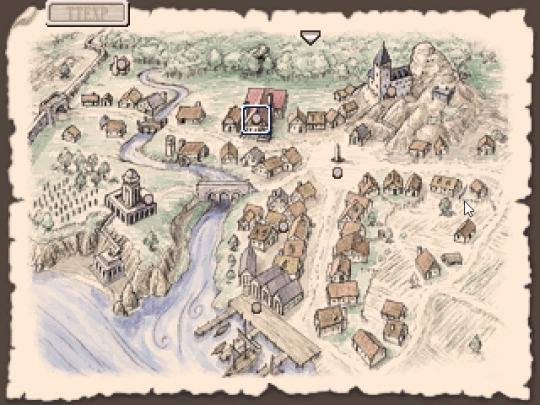
There’s something to Ruina that grounds it in the Japanese RPG tradition, rather than a straightforward riff on Wizardry or Might & Magic. Those earlier games gave you several choices as to building your party, but little in the way of story or character. Ruina is a far more curated experience. On starting the game, you’re offered four “backgrounds” that align you with certain other characters, just one year before Dragon Age: Origins would pull a similar trick. Rather than being given the full freedom to explore a sprawling world, your options are limited to navigating a single, contained dungeon. The characters available to be recruited into your party have defined personalities and quirks — some are already good friends of yours, others are insufferable, and still others have significant flaws that speak to the kind of person they are versus their gameplay function. These are NPCs out of the Baldur’s Gate school, given the illusion of life, rather than the team of personalized murderers you’d recruit in an Etrian Odyssey game.
Very little else in the Japanese games scene is like Ruina. You could draw comparisons with games like Unlimited Saga and Scarlet Grace, representing the legacy of controversial SQUARE ENIX auteur Akitoshi Kawazu. You could similarly connect Ruina with Yasumi Matsuda’s experimental Crimson Shroud, which takes influence from tabletop to the point that it has the player rolling dice in-game. But Ruina is more accessible and polished than a Kawazu game, and far more fleshed out than Crimson Shroud. Even Etrian Odyssey, with its comparatively barebones story and characters, doesn’t quite compare. Ruina stands alone in the Japanese free games community, a legendary title that people respect but don’t fully understand how to replicate.

A few days ago I reached out to Kastel, an academic, writer, and translator who is very familiar with Japan’s RPG Maker scene, about where Ruina fit in Japan’s wider field of indie games. “I know many people in the furige (free game) scene who love the game to death,” they said. “But they also found it to be a hard sell due to its unique, almost western take on the scene. The fact that the game is even this popular speaks to something.” Despite its crunchy mechanics and niche inspirations, the game is popular enough to have spawned light novels, an honor not unique to it (other RPG Maker games have accomplished the same) but certainly significant. Kastel drew a comparison between Ruina and Darkest Dungeon, another weird and uncompromising game that draws from both Japanese and western RPGs. “Ruina is sorta different from everything, but you also see dungeon crawlers get inspired by it,” they said. “Not all games take direct inspiration, but you can’t help but see a little bit of Ruina here and there.”
So why did it take so long for anybody to translate Ruina? Dink isn’t the only person to try his hand at translating it into English; just last fall, another forum dweller placed an ad recruiting a translation team to tackle the game. The unfortunate reality is that translating text within the RPG Maker engine into English requires intensive and repetitive labor. “There’ve been tools developed by vgperson [a prominent translator of RPG Maker games] for RPG Maker 2000 and some other machine translation tools for newer games, but they all remain difficult to use for translators,” Kastel says. “The way games are scripted uses events inside the map and developers rarely name them. So not only do you need to edit it via the appropriate RPG Maker engine, but you also need to go through each event contextless unless the creator actually notes things down.” So, the enterprising Ruina translator doesn’t just need to translate all the text in the game into English. It isn’t even a question of whether or not to manually edit the game’s many pictures and custom menus into English by hand. It’s the sheer difficulty of navigating between thousands of (often poorly labeled) events and variables in the RPG Maker engine, ensuring not to introduce any new bugs or errors in the process, while also finding the time to do all of the above.

Dink was assisted by a friend of his named bool, who played through the game alongside the translation process and gave invaluable advice and fixes. “Uncovering the mystery in the game's story sort of ran parallel with the translation of the game itself,” bool says. “As the story progressed, the characters would decipher and learn more about the lore of the eponymous ruins within the game, and as the translation progressed, the same held true for us. It really captivated me to be a part of this process, and I started to look forward to each new area that I could explore and each new morsel of the story I could understand.”
Without bool’s efforts, it might have taken far longer to put together something workable. As it was, it took four exhausting months. “I worked long hours — 12+ hours a day, 6, sometimes 7 days a week on top of my day job — and very rarely used my free time on anything else,” Dink says. “I did manually input the text in RPG Maker 2000, which has raised some eyebrows because there are some very nice tools available for game translation that would have saved me a lot of time. However, a huge advantage of working directly in the editor is being able to see the game more or less as it appears to players. A Notepad file streamlines the basic translation process, but it also heavily obscures context, whereas the editor allows you to see what switches and variables are being used, what music is being played, and sometimes even helpful creator comments, all in the same relative order you'd experience it from within the game.” Dink had one more secret weapon up his sleeve: the experience of working with the RPG Maker engine as an adolescent. RPG Maker has a reputation of being a tool designed to churn out Dragon Quest clones with ease; but nobody knows the intense difficulty of forcing the engine to do something, anything, like a former RPG Maker developer does.

The English version of Ruina, as it currently exists, is a workable but inevitably compromised version of the game. Running the game requires installing the Japanese RTP pack of visual and audio resources for RPG Maker to function, along with the use of the EasyRPG player to provide English-language player name entry. There’s the matter of the custom menus, as well. Several of the menus have been replaced with functional English equivalents, but by Dink's own admission they could use an expert's attention to better compare to the original. Other pictures, such as place name displays, have yet to be replaced by English-language equivalents at all. And the strict character limits of RPG Maker 2000 led to some creative truncating when translating from Japanese to English, especially with item and skill descriptions.
But the existence of an English-language Ruina, one that renders the whole game playable from beginning to end with a readable script, is a miracle. Speaking for myself, I started the long process of learning Japanese two years ago in part so that I could one day play this game, never expecting there might one day be an alternative. Others in the Japanese RPG Maker scene, knowing the brutal difficulty of translating a game made in the earlier engines, were shocked that a game of Ruina’s complexity and length was successfully translated at all. Speaking for themselves, Dink and bool insist that their own story doesn’t matter much. What matters is the quality of the original game and the hard work developer Shoukichi Karekusa put into its creation. Anything else is an addendum, another version of the game that — while it cannot ever be the original — might at least make something resembling that original experience accessible to others.

Frankly speaking, I think there’s something to that. The “true” version of Ruina will always exist in its original form, released for free by Karekusa in 2008. It stands as the defining work of a creator who sought to create a unique experience combining the appeal of console and tabletop roleplaying games, with no concessions to market sensibilities. A creator who not only released their baby on the internet for free, but insisted that a game like Ruina must always and ever be free. An austere monolith, it stands side by side with Yume Nikki, Ib, and even Cave Story as one of the great works to come out of Japan’s independent scene. Now any English speaker can pick up and play this new version of Ruina, and learn what that monolith is and where it leads to.
You can download the English translation of Ruina here. For those who want to learn more about the Japanese RPG Maker scene, I recommend checking out Kastel’s page here.
Are you a Ruina fan? Let us know in the comments!

Adam W is a Features Writer at Crunchyroll. When he is not working through exercises in Wanikani, he sporadically contributes with a loose group of friends to a blog called Isn't it Electrifying? You can find him on Twitter at:@wendeego
Do you love writing? Do you love anime? If you have an idea for a feature, pitch it to Crunchyroll Features!
By: Adam Wescott
4 notes
·
View notes